#it's much more entertaining than the entire 2010's run
Text
The 2010's run of Archie was.... bad
Too many crossovers, too many multi parter stories that just dragged on for too long and I didn't even care for half the new characters introduced aside from like Kevin
#i finished reading all 666 issues of archie the other day#no i am not joking that IS the amount of issues it ran for#i refuse to read the 2015 one so I just went on to pals n gals#it's much more entertaining than the entire 2010's run
1 note
·
View note
Note
pls share some of your spn fic recs 🥺🥺
ok, a few things first:
followers and mutuals who do not have supernatural brainworms, kindly avert your eyes
i don’t normally rec or even read much fanfic any more but this is a CRISIS ok (cont.)
there is so. much. content for deancas out there and i have incredibly high standards, several ancient ao3 bookmarks, can speedread, and want to spare you guys the experience of wading through it all.
i also have a section for spn femslash since I was pretty into that back in the day (sadly a lot less fan content for this :/)
I don’t really like au’s or pure smut (I honestly usually just skim or skip those scenes) so if you’re mainly looking for that kind of thing this probably won’t be very helpful to you. jsyk.
i’m not great at describing stuff but i’ll do my best, i’ll also try and add tw’s when neccesary.
i wil try and keep updating this with any other decent fics i find, feel free to rec stuff too since i’m like 7 years behind.(edit 1/25/21) this is getting looooong so i’m going to start making another list on my spn blog rather than update this one
(edit 1/3/21) since this has gotten pretty long i’ve added rating/approximate word counts and marked my particular favorites with an asterisk.
Dean/Cas fic:
So Says The Sword*** - explicit/85k. FUCK its good...au/time travel where dean is not pulled out of hell by cas and says yes to becoming the michael sword. honestly could serve as an alternative to actually watching the show, if you want to get into dean/cas without actually doing that to yourself.
Fata morgana.* - teen/6k, pst s9 finale. very bela centric and i love it, she finds cas looking for dean in hell.
Redemption Road -misc/600+k. an incredibly long fic from a collaborative writing group back in the day. canon divergent from the end of s6 on, has a cool take on godstiel and the leviathans, as well as the lovecratian mythos connection. ngl when i reread it i only made it about 28% in but imo the casual reader can actually stop around there, the rest concerns a lovecraftian apocalypse that is still good (i think i don’t remember it very well) but not required to enjoy the first half. if you prefer i have an ebook version i can send you on gdrive.
Someone Who's Feeling For Me* - mature/45k, s12. they run into lisa braeden and dean thinks cas is into her while cas thinks dean still likes her. treats lisa way better than the show ever did and the miscommunication is pretty funny rather than annoying.
a turn of the earth - mature/95k. time travel fic where cas from s10 keeps showing up in deans life from a few years before s1 to right before the hellhounds take his soul. slow burn, good character study, and at one point cas punches the dad in the face and it rules.
On the Wings of War - teen/85k, canon divergent s5. dean accidentally becomes the Horseman of War. plays fun, fast and loose with biblical lore, michael has some rights.
Named - mature/95k, alternate s5. EXTREMELY blasphemous in a fun sexy way. manages to predict metatron almost to a T. there’s one major character death and its literally jesus christ, everyone is very sad about it and it sets the rest of the story rolling. an alternate interpretation of cas’ mission to raise dean from hell which had me on the floor. ngl its kind of misogynistic at points, but its from 2010 and tracks with late oughts-2010 spn (sorry anna the author did you dirty here:/).
The Girlfriend Experience - explicit/15k. uhhh i don’t normally rec or even read smutty stuff unless someone i know is specifically asking for it but this has stuff like sam trying to be a good ally and dean thinking holding hands with cas is ‘kinda gay :/’ minutes after having gay sex with him.
i crippled your heart a hundred times - explicit/19k, s8. cas confesses his feelings and dean spends a long time getting his head out of his ass about it. truly hits different after the actual confession, despite being written six years early it feels like its actually what could have gone down more or less if the writers weren’t talentless demons who hate us.
My Roots Take Flight** - mature/125k. reverse au where cas is a hunter and dean’s an angel...OR IS IT???? an alternate retelling of s4. tw for briefly being set in a psychiatric hospital/the hospital being mentioned somewhat frequently throughout the fic, plus more references to torture in hell and heaven than usual.
The One Thing You Can't Lose* - teen/4k.you know those posts about how cas is a super-strong super-tough ancient warrior but he just lets dean tug him around because he likes it? thats it thats the fic.
Hands, From Which All Things Are Built - teen/14k, post s8′s ‘goodbye stranger.’ cas is on the run with the angel tablet but keeps in touch with sam and dean by text, he and dean still manage to be terrible at Actual communication.
Autrement, Danger - or, The Account of an Exceedingly Long Day - mature/30k, post s11. a monster that takes the appearance of your soulmate leads to some wild miscommunications and dealing with years of repression, also dean gets to see cas’ true form which is always cool. tw for non-graphic mentions of underage sexual assault/sex work.
Down to Agincourt - mature/explicit/900++++k, endverse continuation. endverse!cas survives his encounter with lucifer and discovers another time-displaced dean from s7. i’ve only read the two of four parts but its really good, veeeeery slow burn, has a lot of fun oc’s and takes a rather surprising but (imo) entertaining and intriguing turn into Hellenic history and mythology. usual tw’s for endverse/endverse!cas but nothing graphic, it’s actually pretty light-hearted (relatively speaking of course).
Nothing Equals the Splendor** - explicit/8k, THEE finale fix it fic you’ve been waiting for! posits that the entire final episode was just a (very bad and lame) djinn’s vision.
like moses and batman and james dean - explicit/31k, post s8. explores dean’s trauma and internalized homophoba from his technically canon experience with sex work and its impact on his relationship with cas. the sex work itself isn’t really shown in any detail but it’s still a relatively heavy fic.
Crazy Diamonds - explicit/25k, s4/alternate s14. fresh-out-of-hell dean and dean from 10 years in the future are displaced from time and sent to each other’s present.
where the weeds take root - explicit/30k. au where the men of letters kick them out of the bunker and they accidentally move out into the country, get over their codependence and semi retire. featuring chicken coop building, sam volunteering at a dog shelter, gardening, and blissfully mundane domesticity.
No Resting Place - teen/6k. djinn dream fic, switches back and forth between cas’ dream of being married to dean and retired from hunting to the aftermath when he wakes up. tw for brief mention of suicide since, y’know, djinn dream.
any port in a storm - mature/52k. post s8 finale. cas and dean have to pose as a couple going through a rough patch for a case and actually deal with their emotional baggage, cas struggles with being human and metatron is up to stuff.
all this and heaven too* - explicit/7k. in the author’s own words ‘...a love letter to every trans person who ever projected onto Dean Winchester.’ absolutely unzipped me emotionally and theologically, its just. so good. tw for very brief mentions of internalized transphobia/dysphoria.
Because it is* - mature/6k, finale fix it. killing chuck does not bring back anyone back and the winchesters spend a very long time dealing with what they’ve lost, cas and dean SOMEHOW still manage to have signifigant communication issues even after the confession. tw for suicidal thoughts/brief attempt.
Vena Amoris and Other Old-Fashioned Bullshit* - teen/4k, s6. when cas fell for dean it automatically soulbonded/angel married them, shenanigans ensue when dean finds out during the angel’s civil war. funny and actually written back when s6 was airing so cas is still (or at least pretending to be) kind of an OP asshole which is fun.
Rinse, Repeat - teen/3k, s8. angsty character study of cas as he’s reprogrammed and trained to kill dean. not really dean/cas since its just cas’ pov of canon events but its beautifully written and ends with him snapping out of it through the power of love (also now a canon event!).
Emergence - explicit/59k, canon divergent after s11. dean meets a hunter he only recognizes as their friend claire novak’s missing father, but soon realizes he might be the answer behind the mysterious void in his memories and feelings (aka everyone’s memories of cas are completely wiped away for three years).
Cuckoo And Nest - explicit/10k, early established relationship/character study, cas tries to figure out how he fits into dean’s life and space in the bunker.
Build a Home* - teen/20k, canon divergent s12. sam and eileen are cute and turn the bunker into men of letters/hunters hq and everyone but cas moves in, mutual miscommunication issues and pining ensues.
Down in the River - teen/5k, early s8, cas prays to dean in purgatory while sam and dean try to figure out a way to get him out.
Teaching Poetry to Fish* - mature/52k, ?? BC through the entire series/canon divergent s14 and 15. retelling of crucial scenes throughout the shows timeline from cas’ pov, feat. actual fish and poetry.
the minor fall, the major lift - gen/4k, post confession/finale fixit. dean goes into the empty to save cas and runs into several old friends (and enemies).
With the Kisses of His Mouth* - teen/3k, gen later seasons. dean and cas keep kissing by accident.
Remaining Grace - explicit/109k, alternate s6. au where cas asks dean for help with raphael and dean, of course, does. tw for temporary major character death/semi-graphic depictions of alcohol withdrawal.
The face of heaven.* - teen/10k, au, dean is a regular guy and cas is a fallen star (think ‘stardust’, kinda).
Stories Are Made of Mistakes* - teen/5k. newly human cas has trouble getting used to a human body and humanity in general, but still figures out that he and dean are A Thing before dean does.
Hurry Up And Wait - mature/21k, canon divergent s12. a fairyland and quite possibly LOTR related case comes up and dean goes full fanboy, mary is introduced to the wonders of the peter jackson adaptions, many references and comparisons (including between cas and dean’s ‘friendship’ and arwen/aragon). also charle is still alive and has just been doing fairy stuff this whole time.
There Are Many Things - explicit/28k, s9. cas is extremely lonely/touch-starved and trying to figure out this whole human thing, as well as where he and dean stand after being kicked out of the bunker.
It's A Long Life to Always Be Longing - teen/40k, post s11 finale. amara helps dean by putting him in a magical coma so he can finally get some much needed rest and show him possible futures for him, sam and cas. meanwhile sam and cas go on a roadtrip (or several) to find componets for a spell to wake dean up. really good sam and cas friendship, they actually talk about their shared lucifer trauma and stuff.
Non-Photo Blue - gen/2k, s4/5/alternate s5. fifty moments from cas’ memories of dean.
Tall Grass - explicit/57k, canon divergent post series. cas becomes the ultimate plant dad. feat the wayward sisters gang, cathartic character growth, fun oc’s, domesticity, and lots of actual botanical info-dumping.
on vessels - no rating/gen/2k. established dean/cas, cas tells dean about how he used to imagine what it would be like to have him as his vessel.
search for tomorrow on every shore* - teen/11k, post-finale (extremely derogatory). some angels in jack’s new heaven act out and dean gets temporarily resurrected in 2003 and runs into his younger self.
Architecture of the Minotaur’s Heart - explicit/45k, very canon divergent post s1. dean’s new house seems to have a life and mind of its own, while in his dreams he sees glimpses of a world and apocalypse that never came to be and an angel that looks strangely like his mysterious neighbor, cas. loosely inspired by the book house of leaves (which i highly recommend for fans of weird horror).
The Distance Of The Setting Sun - explicit/17k, post s5. established dean/cas relationship, team free will finally takes advantage of cas’ abilities to go on vacation around the world.
diamond star halo - teen/5k, s11. dean lets cas use him as a temporary vessel while he recovers from rowena’s spell, sam is a long-suffering third-wheel.
Make Known** - teen/16k, s6/7. dean struggles to understand how cas could have become his enemy and whether he ever truly knew him in the first place.
blunt little instrument* - mature/1.4k, post finale. dean finally confronts his father in heaven, very cathartic.
my heart a compass*** - teen/10k, post confession. the empty forces cas to re-experience his most regretted moments while dean tries to snap him out of it and bring him home.
A Crash Course in Someone Else's History - teen/11k, s6. cas from the very start of s4 is brought forward in time by s6!cas to distract the brothers from his and crowley’s plans.
The Cuckoo Father - mature/8k, s7 au. the woman who found cas in the river post-leviathans does not marry him bc he was sent to her by god or whatever, but actually identifies him as jimmy novak and sends him back to claire and amelia.
The Dead Dean Clause* - teen/5k, post alt s5 ending. team free will celebrates surviving taking down lucifer by getting blitzed, cas lies to a cop and gets an impromptu driving lesson. title/description sound dark i know but it’s actually very funny and light.
Suck It, Judy Garland - mature/20k, s12 (after the ‘i love you...i love all of you’ episode). cas and sam have to pretend to be a couple for a case and dean is NOT happy about it.
By Daylight and In Dream - teen/16k, s5. pre-dean/cas, dean invites cas to use his dreams to hide from the other angels. tw for very brief mention of a memory/dream of alastair sexually assaulting dean.
The Five People You Meet in Heaven - mature/22k, post-canon. an actually happy (if sometimes bittersweet) heaven endgame written several years ago, though some details are rather eerily similar to the show’s ending.
heaven is a place on earth* - teen/2k. dean’s pov of some of the times cas left him behind throughout the show, and one alternate ending where he finally gets to stay.
I Cleanse The Mirror - teen/20k, alternate s6. dean’s body is stolen by an ancient elemental and his soul has to hitch a ride in cas’ vessel.
an exploration of gender; angelic*** - mature/4k. *oscar isaac voice* lets get into angel gender politics!! aka cas is trans.
Zenith - explicit/33k, s9. after 9x06 an angry witch curses cas with the ability to see supernatural beings and human souls.
La cucina. - gen/3k, alt s9. dean goes wild helping a newly-human cas find out what kinds of food he likes, or the early s9 domesticity we deserved!
Dean Winchester, Cocksucker at Rest***** - teen/7k, post-finale. john and mary finally come over for dinner and john reacts to dean/cas in a rather predictable fashion. SOOOOOOOOO good omg, its so funny and a little sad and very very cathartic. part of a series that has a few other really good short fics.
The Way You Didn't Go - teen/5k, s15. coda to 15.09, dean has nightmares about the moc!cas timeline.
On Drowning - teen/28k. dean saves cas after he nearly drowns, they both try and deal with the physical/mental fallout (aka the fic where thee iconic “you only touch me when you think I’m dead or dying” originates). tw for realistic depictions of drowning/triage/misc medical information.
The Thirty-Six Questions That Lead to Love* - mature/13k. claire has dean and cas pretend to be her gay dads for a case and they play the titular 36 question game, get mistaken for swingers, and birdwatch, among other things.
Assorted F/F stuff:
Deep Breaths* - mary/ellen, au where mary said no to azazel’s deal and let john stay dead, still becomes a milf.
Like Rebel Diamonds - krissy/claire, they become hunter gf’s on the hunt for cas to kick his ass for taking jimmy. not-so-stealth dean/cas as well.
To Ash and Bone - anna/ruby, same author as the previous fic (p much all of her stuff is good from what i recall). au where ruby is a witch and helps anna when she’s cursed.
Holy Clockwork Angels - jo/ruby, STEAMPUNK au with very cool worldbuiilding.
At Day's End - jo/anna (my fucking KINGDOM for more jo/anna content, the dean/cas parallels are allllll there), au where they are both at the camp in the endverse and gfs.
these posts - ok so not actually a fic but i’m now obsessed with this hannah/meg dynamic.
Tagelied - mary/ellen, the true story of how ellen got into hunting before angels interfered.
Hell's Bells** - meg/abaddon, alternate s8/9 where meg survives crowley’s attack with sam’s help and teams up with abaddon (who she has a sk year old crush on) to take back hell.
The Ecstasy of the Rose - anna/ruby, anna travels back in time to escape heaven and becomes a signifigant part of ruby’s old human life.
Angel Underground - anna/jo, kind of an urban fantasy au with a very intriguing premise (sadly its very short, i’d love to see more if this ‘verse).
Clover, Flame - billie/mary, billie was always the reaper that showed up to take mary after her death(s) over the years.
Drag Me To Heaven - anna/ruby, a variant on the ‘last night on earth’ thing with dean.
Come Home* - jo/anna, canon-divergent au where anna is the new waitress at the roadhouse and helps jo set up a (probably not really) haunted house for halloween.
#if you told me i'd be doing this in 2020 three weeks ago i'd have laughed in your face :/#deancas#supernatural#fic recs#spn femslash#destiel#fic#the alie tag#spn posting
2K notes
·
View notes
Text
Nostalgia sells - or does it? About BBC’s rehiring of a previous showrunner for Doctor Who as a marketing strategy
All, right, this is the one where I deal with my issues about RTD’s rehiring from the standpoint of BBC’s business strategy . Brace for passive agression, swearwords, brief history of british television and numbers. So, so many numbers.
Allright, so I already wrote a post about my problem with RTD’s (re)hire from the creative standpoint (it’s here in case you’re interested), but hey, I can bitch about it all I want, but we all know what caused the BBC to make this decision, right? You’ve heard about it for sure. The Dropping Ratings. You’ve read about it on so many posts, lots of them probably oh-so-gladly conflating this fact with their own opinion about the deteriorating quality of the show. (Don’t worry, we’ll get to that.) So Obviously the execs at the Big BBC Quarters needed to do something about it, and what better way to go than rehire a guy who’s run at Doctor Who is a warm childhood memory for so many in it’s fanbase? After all, it’s what we’re seeing nowadays: from Star Wars return to wave of 80′s nostalgia to every old blockbuster star doing a comeback, there is but a single conclusion - nostalgia sells.
Or does it?
Part One: Moving with the change; or very much refusing to.
Let’s start this off with some facts about the ratings for Doctor Who. (Well, I warned you there’s gonna be numbers, didn’t I. Stick with me, I’m going somewhere with this I promise.) In it’s beginnings, in the sixties and seventies , the series flown high, averaging a viewership from 8 up to 10 million viewers per season. Collin Baker’s series 17 brought in a record of 11.21 milion viewer asses in front of a good ol’ TV screen, real champagne opener here. But, as it happens, things were downhill from here. During the eighties, the rating started dropping steadily, reaching an all-time low of 4.15 milion couch-warming bottoms in 1989, the last season of the classic era.
Years passed, 16 of those years to be exact, and here comes our saviour RTD. Under his wings, the revived series premiered, bringing in over 10 milion viewers to the premiere episode of season 1, Rose. A viewership this high did not last for long, but still, RTD’s seasons averaged between 7 and 8 milion viewers per season, which seemed pretty respectable. But then, as the story likes to repeat itself, not unlike the bbc execs just did, along came the decline again. Ever since 2010, the ratings began steadily dropping again, from 7.95 in 2010 to 5.46 in 2017. Then DW experienced an unexpected peak in 2018 with the premiere of Jodie Whittaker’s first season, which averaged 7.96 viewing asses, but then continued the dropping trend on the next season, averaging 5.40 viewing butts.
So what went wrong?
You see, part of the reason that Doctor Who was bringing in such great viewership numbers in the 60′s and 70′s, was that, to put it simply, BBC did not have much competition. Or, to be exact, only had one competitor. ITV was literally founded in order to break BBC’s monopoly over British television. But in the 80′s, with the launch of Channel 4 and Sky, the british viewers had more and more options to choose from. So logically speaking, they no longer had to watch BBC’s programming just because there was nothing else on. There was more and more new programes to boredom-watch. And here’s something y’all need to know about the tv industry: the boredom-watchers, the casuals? That’s the most important demographic. As hard as it might be to swallow, us hardcore fans, forum dwellers and Ao3 gremlins, we’re not as big of a group as we’d like to think. Loving fans are important to the tv execs as providers of word-of-mouth advertisment, but the real numbers come from the casual, everyday viewer who will just put on the next episode cause the other one was kinda fun I guess. Or more fun than the other options, anyway.
And this is why, by the way, when someone is conflating low viewership with the show Dissapointing The Fans, they’re full of shit. I’m sorry, but we’re really not that much of a force here, definitely not enough to make such a big impact on the numbers. Another factor, that some of you probably noticed already, is that the numbers I’m quoting are from british tv only, while the online fandom is very much international, so our opinions matter even less to the british execs, I’m sorry again, hard pill to swallow I know, but true nonetheless.
But I digress. So, to sum up the previous paragraph, Doctor Who’s viewership decline in the 80′s was the effect of the changing landscape of the TV industry, with which the BBC struggled to come to terms with.
Sound familiar?
Let’s move on to the 2010′s, shall we?
2010 was is actually a good marker of a year to choose, because it marks one important thing that begun a big change in the industry. This was the year in which Netflix expanded their services overseas, from being a DVD rental company to providing VOD services. Over the next decade streaming services grew in importance, from being an add-on to your cable TV that you didn’t really want but they were throwing it in for cheap, to very much self-sustainable media services you might very well buy instead of buying the cable. And if you look at the numbers for Doctor Who viewership declining over the last 10 years, that’s precisely what’s been happening. It’s not that people don’t want to watch Doctor Who on tv, they don’t want to watch tv in general. Do you know what was the most popular channel in Britain this year? Can you guess? Fucking Netflix that’s what. It’s just slowly-yet-steadily ceasing to be the way we use home entertainment anymore. Again, not much to do with the audience approval, because for that matter, let’s see about the specific episodes that saw the spikes in viewership.
Rose, which i mentioned at the start of it, was for the longest time the unquestionable queen when it comes to viewership, at 10.81 milion. The next episode, The End of the World, pulled in 7.97 - almost 3 millions worth of lost viewer-butts in one week? Is it because it was so much worse than it’s predecessor? No, it simply did not have the smell of Newness, the Event You Must See, and as such brought forth less of the casual viewers who were simply curious about The New Thing. The next season followed the similar formula, peaking at the premiere, when the marketing was at it’s strongest, going down during the season, sometimes rising slightly for the finale, sometimes not. The most popular episodes are, of course, the specials - yet again, the vibe of The Event To Be Seen worked here, but one more thing working to their advantage is they often aired in spaces between seasons, serving as both a long-waited Crumbs of Content for the fans, and the basically stand-alones for the casuals. Do you know what the single most watched episode of revived DW is? No, it’s not Tennant’s goodbye with the role (yeah I know, I thought it had to be that as well). It was Voyage of the Damned, between seasons 3 and 4. The perfect standalone for the casual watcher. And last but not least, you know one more special feature that brought, maybe not as much, but definitely more than expected? The 1996 movie Doctor Who, with 9.08 million. Again, a perfect standalone.
But the standalones aren’t the only way to grab the viewership. The currently-highest viewing non-special episode of DW? The Woman Who Fell to Earth, Jodie Whittaker’s introduction. In 2018 no less, in the year when the streaming was the ruler supreme, this episode brought a whooping 10.96 million buts to the good ol’ TV again. Let me reiterate: this episode brought in more viewers than Rose did in 2005, while having WAY more competition and way less favorable circumstances of release that RTD’s debiut did. Not only that, it managed to bring on some numbers for the entire season as well, not as good of course as the premiere (because again, the Event vibes faded), but still brought a better average than the last six seasons did. (Again, let me reiterate: more than the last SIX seasons. More viewership than any series since 2010, since the Streaming Wars.) So clearly, this must be the way, right? Catering to this Weird New Trend, that saw directors notice there do in fact exist other actors than white men, that surely brought in some profit, even Marvel does it now, right? Out with the old, in with the new!
Part 2 The Deceitful Charm of Nostalgia
Well, it turns out the whole Doing New Things deal didn’t work out that well after all, now did it? The second season penned by Chibbnal averaged 5.40 milion, that’s 2.5 million drop from the previous one! It must mean it didn’t work, right? Well, yes and no. As much as the refreshment of the formula as simple as Let’s Put A Woman In It absolutely worked for one season, it very visibly did not hold up for longer. An Event-Episode is something that can still happen on TV, Event-Series? That’s pretty much reserved for streaming now, if you think about it, and it’s honestly kind of a miracle that Series 11 did as well as it had. Two consecutive Event-Series on network tv? Flat out impossible.
So how to make those ratings great again? How to get those butts in seats of the Good Ol’? Well, the execs of the BBC have a plan for that. They brought in a devouring beast, and it’s name is: Nostalgia.
Without a doubt, there is a number of people who feel nostalgic about RTD’s era of Doctor Who. It’s a lot of people’s fond childhood memory, or the series they started with, and judging by the numbers, there should be quite a lot of them. So the new plan, as it appears, is to get to those who maybe lost interest in the show and lure them with the promise of the thing That Is Totally Like The Thing You Used To Love, Remember? (This is why I don’t actually think that RTD will be allowed to do anything new and interesting, that’s not what they hired him for. And that’s why I think this is bad from the creative standpoint.) So there are two questions here: One, will the people be lured? And two, for how long?
Nostalgia as a marketing strategy is something that you’re probably sick of seeing already (I know I am). But it has very much been effective on many levels, especially the eighties-baiting, Stranger Things style, can bring a new IP up to relevance. But what about old IP’s that want to have a comeback?
It’s kind of dificult to find another TV show that I could compare to Doctor Who. Most series that have been running for that long are mostly soap operas, that operate on slightly different rules, and are also targeted to a different audience. So as much as the movie series is still not exactly the best comparison, when I think about a big IP, campy sci-fi, family-oriented (at least in theory) on its path back to relevance, I think about Star Wars, obviously. The Force Awakens gambled on that nostalgic feeling and won big, but the next two movies, while still financially successful, were nowhere near the astounding success of the first one. And that’s because - you guessed it - it created the Event You Must See again, The Great Comeback, but merely two years later, the comeback became old news. So what we can gain from that is that nostalgia can create an Event as well as a new trend, if not better. But the question remains: how long will that last?
That is, after all, the main difference between a movie franchise and a TV series in the traditional, network TV sense of the word: movie franchise must bring in the viewership every year or two, and TV series must bring in viewers every week for at least two months. Is RTD’s Nostalgia Vibes enough to provide for that?
I’ll say this: I’m absolutely certain that the 60th anniversary will be very popular. I still don’t think it will break any records because, as I’ve been trying to explain for this whole post, it is not 2007 anymore no matter how much the tv execs would like it to be. But ironically, the almost-certain success of the special is the very thing that could undermine the effect of bringing their precious Nostagia Boi back onboard. Remember, the first Event Episode is The Big Oof. That’s the one that gets asses to the Good Ol’, if anything ever does. After the first big event one, that’s the point when things start going down. They’re wasting their Special Event Boi for something that already would be an event, dear fucking gods, I hate your plan and I would still execute it better. Either have RTD be the Anniversary Guy and then hire someone new, use that hype and keep it going, OR have RTD come in after the anniversary, then at least you get the Event Effect for the premiere of his first return season. Fukin’ amateurs.
But even if they did that, here’s the thing: do you think that the people who departed from the show years ago actually want to watch another three to five seasons of The RTD Show? I mean, I’m sure the thought warmed some hearts, for sure. A number of people will definitely gladly watch the anniversary, probably the first few episodes of the first return to the basics, but after that? In the world when, due to streaming, they have an easy way to revisit the actual thing they’re nostalgic towards? I honestly don’t think so. And you’re not really gonna get many new people by going back, if that nostalgia factor isn’t there. And then there’s casual viewers, the backbone, as we established. And here’s the thing: lots of those people don’t even know who the current showrunner is, cause they’re not Terminally Online like we are, and the second thing? Lots of those people ARE JUST NOT WATCHING NETWORK TV, IM SORRY GARRY. They’re just. They’re just not. I don’t know how to spell it out better. Even my mum has netflix now. Your biggest base is in another castle mate, gotta get moving and gotta get moving quick, cause here’s another thing: all the nostalgia in the world will not do SHIT for you if your target, people who were kids/teens when the RTD era was airing, PROBABLY DON’T EVEN HAVE A FUCKING TV ANYMORE CAUSE THEY MOVED OUT OF THEIR PARENTS FLAT AND LOTS OF YOUNG PEOPLE JUST DON’T BOTHER. Just. I’m sorry but you’re trying to resuscitate a decade-deceased corpse there buddy. It just won’t work. The times have changed and you gotta swim or drown, and it’s just not gonna be 2005 again, no matter how hard you pretend it is. It’s not your content it’s your business model. Just push more marketing for your iplayer or whatever, focus on streaming as your primary not your secondary cause that’s just what it is now, and maybe don’t rely on the viewer-counting systems of the yesteryear to evaluate your business. Or else you’re gonna get stuck sacrificing the creative growth of your show for a marketing strategy that probably won’t even fucking WORK.
There, I got it of my chest. Feel free to reblog, and also: you somehow got to the end of this, congrats! I’ll make numbers nerds out of y’all yet.
#it's like. my sister and I were#watching a movie lately. the one with multiple will smiths and the de-aging tech#(don't recommend it it's real boring)#but when Youngened Will Smith appeared on the screen my sister got my spiting my tea laughing by innocently saying:#"oh i don't know this actor. it's nice that they're giving opportunities to the young actors. great to see a new face in the biz''#and u know what#this rehire is the same fucking vibe to me#some cunts from marketing plastering make-up to an old man's face and pretending its 2005 still#anyway#doctor who#i guess.
44 notes
·
View notes
Text
Safe House and Watching Ryan Reynolds Before He Was Deadpool
https://ift.tt/eA8V8J
There’s a scene midway through Safe House, the 2012 thriller which stars Denzel Washington and Ryan Reynolds, that hits entirely differently in 2021. As with any number of films starring these leading men, the stars are cultivating an oil and water relationship in the sequence, one built on mutual distrust and loathing as they drive across a countryside. But in the case of Reynolds, it plays differently than how modern audiences likely expect. When Washington begins trying to get under the younger guy’s skin—poking at his insecurities like he’s Ethan Hawke in Training Day or pretty much the entire cast of Man on Fire—Reynolds is visibly shaken. He then folds like a cheap suit.
“Go ahead, you’re not going to get in my head,” Reynolds’ Matt Weston protests as he seemingly holds power over Washington’s Frost character. “I’m already in your head,” Washington smiles back. “I’m going to isolate you, Matt.” And by watching both actors, you believe him.
The sequence is boilerplate thriller dialogue, a generic sequence in a generic movie (at least in the 2000s and early ‘10s). But to see Reynolds play it so straight and so differently from what his star persona would later become is slightly jarring. For the first time in ages, it feels like you’re watching the actor play a character who isn’t Deadpool.
This thought occurred to me while revisiting Safe House this week, particularly in lieu of the film trending so high on Netflix. While the picture was a modest success in 2012, earning $208 million worldwide off an $85 million budget, it’s easy to assume many audiences are discovering the film for the first time due to the globe’s most popular streaming service. And they’re seeing Reynolds in a way unlike any part he’s played in the last five years.
That’s by design, of course. After being unfairly tarred by the cruelest parts of the entertainment press as “box office poison,” the actor who spent close to a decade fighting to get Deadpool made has embraced the Merc with a Mouth persona audiences love. It’s why his version of Pikachu in Detective Pikachu feels both earnest, yet glibly aware of his cuteness; it’s how Reynolds’ Michael Bryce can be as acerbic in his wiseacre sensibility in the Hitman’s Bodyguard films as Wade Wilson; and it’s why his steady post-pandemic hit, Free Guy (which has grossed $302 million as of press time despite the Delta variant), can have Reynolds be both completely earnest and self-aware since he is literally the only character in his world who knows he’s a video game NPC.
While Reynolds only fully breaks the fourth wall when he actually is in his red and black undies, all of these roles are in the same wheelhouse as Wade, as is the actor’s social media image, which has even created a joking alter-ego named “Brother Gordon,” Ryan’s alleged twin brother who sells Aviation Gin, a liquor the actor maintains an ownership interest in.
Which is why Safe House is suddenly so fresh now. Bittersweet, even. On its own, it’s a fairly standard (some might even say substandard) thriller wherein frantic editing and shaky handheld camerawork attempts to evoke a sense of real-world tension and espionage. Washington’s played characters like Tobin Frost before, and in better films, but Reynolds hasn’t played a straight man, or a character with a dawning sense of despair, in a long, long time. What’s more, he’s actually quite good in scenes where his Weston character—a low-level CIA employee that winds up having to both capture and team-up with Frost—is driven to cynical horror at his boss’ realpolitik manipulation, or where he must tell the woman he loves that he’s been lying to her for months and now must ghost her.
This is diametrically opposed to his character in The Hitman’s Bodyguard who has a similar frenemy camaraderie with Samuel L. Jackson on multiple road trips, and yet that guy remains perpetually nonplussed about the constant stream of shootouts and chases he’s in. He even has time to crack wise with Jackson about their rivaling badassery.
The first Hitman’s Bodyguard is a better film than Safe House, but that earlier movie is a reminder that Reynolds is more than just one persona. It’s easy to imagine Safe House is not one of the actor’s favorite films. It’s from that awkward period in his career directly after the notorious box office flop Green Lantern in 2011. Indeed, much of the recurring meta-textual humor in both Deadpool movies is Reynolds having a laugh at Green Lantern’s expense, mocking what it did to his career… including by making it that much harder for Reynolds to get Deadpool off the ground.
Ironically, Reynolds had kind of played Wade Wilson before Green Lantern or Safe House, but in such a bastardized form during X-Men Origins: Wolverine (2009) that 20th Century Fox became skeptical toward the idea there was a large audience out there for Reynolds to have his spinoff. Meanwhile, for every forgettable success like Safe House he was in, Reynolds was only getting mainstream roles in other troubled productions like R.I.P.D. (2013) and The Change-Up (2011).
The irony is, however, that Reynolds was also doing some of his best and most diverse work during this period. Likely a contributing reason to him getting to play Hal Jordan was the box office success he had opposite Sandra Bullock in 2009 with The Proposal. But while that romantic comedy saw Reynolds dabble in the sarcastic wit which marks his earliest breakout success in the sitcom Two Guys, a Girl and a Pizza Place (1998-2001) and his current run of hits since Deadpool, his character in The Proposal is not a smartass. He’s a put-upon employee who is driven by completely earnest and embittered estrangement from his father.
Meanwhile, outside of his would-be blockbuster fare which came after that hit, Reynolds was doing genuinely impressive dramatic work on the indie circuit. His one-man turn in Buried (2010), in which he plays a military contractor who realizes he’s been buried alive in Iraq and has only only a cellphone and 90 minutes before his oxygen runs out, is claustrophobic and viscerally terrifying stuff. Conversely, his depiction of a mentally ill man who begins hearing conflicting advice from “the voices” of his dog and cat in Marjane Satrapi’s The Voices (2014) is arguably the best work Reynolds has done in his whole career. In that dark comedy, he plays both sad sack Jerry with sincere pathos while also truly disguising his speech patterns by inhabiting the sinister voice as his cat Mr. Whiskers and his sagacious dog, Bosco.
Neither of those films were box office hits, obviously, and none of them earned Reynolds the kind of universal love that Deadpool did. As bleakly amusing as Mr. Whiskers is, that’s not a character who can sell bottles of gin. But being reminded of that more diverse talent now, even while watching something as pedestrian as Safe House, is somewhat nice. He’s gone on to much better mainstream entertainment since 2012, but Reynolds is still more than Wade Wilson. That’s worth remembering.
cnx.cmd.push(function() { cnx({ playerId: "106e33c0-3911-473c-b599-b1426db57530", }).render("0270c398a82f44f49c23c16122516796"); });
The post Safe House and Watching Ryan Reynolds Before He Was Deadpool appeared first on Den of Geek.
from Den of Geek https://ift.tt/3EFfEJI
3 notes
·
View notes
Text
Full review: Girly

What’s Pink, insane, NSFW, hilarious, and somehow heartwarming at points? This comic is a ride and a half, and I’m genuinely surprised more people haven’t heard of this one… I’ve been wanting to talk about this one for a WHILE.
So let’s talk about the elephant in this room… Because I think it just ate someone’s couch.
Slightly NSFW review with spoilers below.
Girly, by Jackie Lesnick was a webcomic that ran between 2003 and 2010, (and really has some of those early webcomic hallmarks). Its monochromatic pink, vertical, with a poppy early cartoon feel. It’s also listed as a romantic comedy, which is… correct, but cuts a whole lot of what makes this comic good, short.
This review was always going to be one of the 4 I really struggled with. And not just because I lost it the first time without a back up in a code glitch, got distracted by a pandemic, then procrastinated my way to finally making a second version in my new backup folder… No, well also yes but no. This was a comic I read when I was younger (and should NOT have read when I was younger), and have always had a soft spot for. I’ll admit as much as this comic has its flaws or weird moments or just weirdness in general, its one of the few comics I’ve found myself rereading in its entirety more than once. And no matter how much I know it's coming, find myself sobbing, uncontrollably, at the final panel. There’s surprisingly a lot of heart in this comic, and a whole lot of honesty in just the direction the author took this weird little thing. But, first let me take of those rose tinted glasses as much as I can… (actually that might not work too well with a pink comic seriously whats with all these early 2000s lesbian comics being PINK?). And give this old comic a look and a bit of a dust. but , first...
Sex.
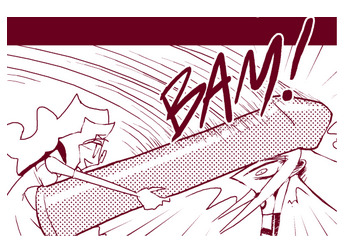
Getting to the point - page 3 of “Girly”
Girly is a NSFW comic. It’s not shy about it either. It hits the audience (and the main character) over the head with it literally in the first pages. It has sex positive characters, a sex positive world, some characters with… sex powers almost, and Dildos, a whole lot of dildos. Some even with smiley faces on them. It’s a pretty unavoidable part of the comic that makes up a large core of it’s humour and is baked into its wacky world. So if that’s not your thing, and it’s not really skippable in this case, you won’t like this comic.
But, if you’re alright with that part of it this might just be a hidden gem. Moving on.
Art
Artwork is always interesting in webcomics. They’re usually one man shows, have a weird niche / strong influences, and or usually go on massive journeys as the art improves. Girly is no different here.
Girly starts out rough. Some poses are wonky and its a bit scratchy. Technically speaking it has a few issues, which is fine. Its a free webcomic, from the 2000s that didn't copy and paste faces. (Won’t name names, you know who you are). You can’t be too harsh on a free comic, though.

However, what the art style does, even early on is set the style and feel of the comic. Anime inspired faces, bold outlines, and blocky silhouettes that were really popular with 90’s and 2000s cartoons. It has a newspaper, manga comedy strip vertical style, too. It fits the style of story well as a poppy wacky story. It's the perfect art style it could take.
Its rough in the beginning, but moves on from its scratchy days, to loose pen brush, to finally a polished free hand poppy style. It gets more technically advanced as it goes along, but it keeps its core style throughout. It’s fun, a little unhinged, and just pares perfectly.
The one issue I have with the art is it comes off as a bit cramped. It certainly matches the energy of the story, but it also feels like it doesn't let the characters have any breathing room in the frame. It comes off as squashed, and can make some character poses hard to read. That’s the only complaint I can find though. The issue even fixes itself later in the story, but just very very close to the end. It looks great there, but the majority of the comic is a little cramped. Still that’s just a small complaint.

Nitpicking here but some panels need a lil more room
This a humour comic foremost. It's the biggest part of what makes Girly specifically Girly.
Humour
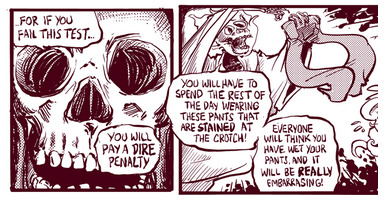
The humour is mostly wacky nonsense, playing off its insane characters, physics defying world, everything being dialed up to 11. It also works a lot like satire, poking at what influences it, and playing with cinematic expectations. The first page has Otra shooting someone into space on a rocket because they annoyed them, the first “adventure” the character’s go on is stealing everyone’s pants because they couldn’t find anything else to do. Then there’s the kidnapping adventures, knight trials, and slice of life shenanigans that happen. All of it as wacky as the last. I haven’t really found any other lesbian comics like it. Its not everyone’s tastes, but it is certainly unique.
If you’re into a willy wonka tunnel of over the top characters and plots, you’ll like Girly.
Characters
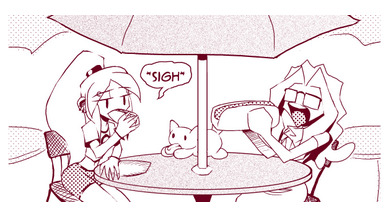
Girl is a LONG comic, it ran for 7 years. The art evolved, the story writing, jokes, and themes along with it. It was originally meant to run for only 50 strips... and it ended up with 764.
so, there’s a lot to unpack.

Firstly, the premise of the story is somewhat simple. It focuses on Otra. The kinda straight man to the entire universe. She starts out almost depressed, out of place, and bored of the wacky inhabitants of her world. Until one of those wacky residents smacks her over the head with a giant dildo and won’t leave her alone for the next 7 years of run time.
What follows is the sullen Otra being pulled around by the always cheery and zany nonsensical Winter as the sidekick for bizarre adventures. Otra’s depressive grounded view keeps the bizarreness funny, while Winter cuts through her negative attitude and causes a lot of the over the top plot. Leaving Otra to warm up to the world, and Winter to get less reckless as they balance eachother out. It’s a fun dynamic, and works as an emotional core of the story. No matter how weird the plot and rules of the world are, their relationship keeps the story somewhat focused and rewarding to see develop.
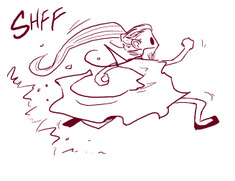
An example of bold wacky character designs from even early on
The comic isn’t just about them, though. As an ensemble comic there's plenty of side characters that go through arcs and beats as well. From el chubacabre, the man that woman find so irresistible that they sleep with him as soon as they see him; detective Clapjaw the street wise detective who is very bad at his job; Officer Hipbone and police guy from the cute P D; captain fist the ever popular bad at his job superhero who gets all the credit; the news reporter obsessed with captain fist; the woman with babies; Steak; the elephants that just… appear and eat buildings; among many many others. A lot of whom also have nicely written character arcs and depth in later chapters. Many of the character however are simple and remain simple, which isn’t a bad thing. For such a large cast, having a diverse range of strange characters with strong identities and looks even if a bit simple stops it from getting bogged down. It strikes a good balance. Plus there’s plenty enough of characters with more depth later on.
All the character’s are insane, and over the top in a way that really sets up the world they live in and how it works... as dysfunctional as it is. There’s something very Cartoon Network about all the characters, but with some wider influences. something about dumb characters, with very specific goals and quirks that work on their own physics to feed into the high energy insanity of the world. Its entertaining to read, and leads to a weirdly charming feel of the comic.
Story and plot
For the bit people actually want to know about. What is it about?

Just a little bit of influences...
For the style itself the comic comes off as a mix between early 2000s slice of life-y anime, 2000s cartoon Network, and a dose of 2000s webcomic sarcastic action/adventure flare. It definitely has one of the most pronounced styles that I’ve seen, and even if it's very much a webcomic of it’s time it also goes a bit beyond that into something that feels personal to the author and honest. Its a batshit comic. But, it wears its influences on it’s sleeve and really plays with tropes and ideas the author found engaging at the time. It somehow comes off as refreshing in just how willing it is to go weird or niche for no other reason but because it wants to. It's what I appreciate most about the comic. It’s honest.
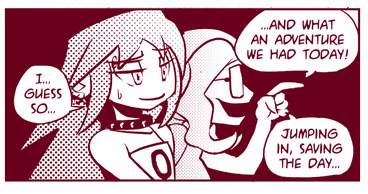
The overarching story of the comic is without a doubt about Otra and winter growing together as people. But with a comic that’s run for 7 years a little bit more happens in the journey, at least you hope it would. Girly runs on chapters, 15 in total (with 15 having sub chapters due to being the story’s climax), and each one of those chapters follows a different plot or adventure with Otra’s and Winter’s developing relationship gluing them together.
The plots themselves are wild and vary a bit in quality. But for a long comic that’s understandable and expected. They go from solving elephant problems, super villains, body swapping, fantasy parodies, and all sorts of strange things. Sometimes a few plots drag and a few character arcs feel a bit bland. It still manages to be entertaining all the way through though. The plots themselves work to get the character’s to play off each other and explore the strange world it takes place in. Exploring evil teddy bears, or an entire town devoted to cheap gags. No matter what, all the plots work in fleshing out the world and pushing character’s out of their comfort zone or forcing them to change. There are some that are less fun than others, but none of them manage to be boring or useless. Which for a long comic such as this, is quite an achievement.
Conclusion
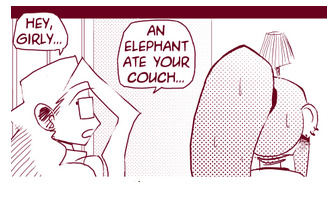
Girly is a hidden gem, Its an insane sex positive comic. A loose style and even looser physics. It’s bold and unabashedly itself. But, at its core it's about the love story of Winter, the wacky insane woman needing to slow down and open up, and Otra, a sullen woman who’s deemed herself only worthy of being on the outskirts of society. It’s two people growing together in a world that’s up to its ears in care bears, sentient dildos, earth shattering cloning, and jabs at 2000’s paste it comics. And somehow it all sticks together.
The characters resonated, at least with me, which may be the nostalgia talking. But by the end of the comic I can’t help but think back on how long it took them to get there. The bits that made me laugh (a lot of them), the stupid parts, and the character’s arcs, as over the top they could be at times. It may not everyone’s cup of tea. But it has a lot of heart at its core. (If you get past all the dildos).
For all it’s flaws and weird bits. I still find myself going back to Girly.
Maybe now, some more people will too.
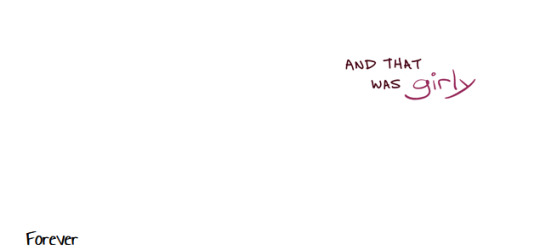
24 notes
·
View notes
Text
My Review of Zombieland Saga REVENGE


Yes, Franchouchou has come back after a two and a half year hiatus.

HISTORY: Zombieland Saga is an idol show.
I have already cut my readership in half with that one sentence alone. But this is no ordinary idol show! A maniacal necromancer named Kotarou Tatsumi brings seven girls back from the dead. A former idol from the 1980’s (Junko), a former idol from the 2010’s (Ai), a child star from the 2010’s (Lily), a girl with idol aspirations from 2008 (Sakura), a former biker gang chick from 1997 (Saki), a courtesan from the 19th century (Yugiri), and Yamada Tae! There’s no describing what exactly Yamada Tae is but we don’t question it as she’s best girl.

Kotarou brought these seven girls back to life in order to save the Saga area and revitalize it. Throughout the first 12 episodes, we watch these girls get the hang of being alive again after so long and become an idol group. With Kotarou’s make-up skills, he’s able to fool nearly everybody that these girls are living, breathing idols. Almost everybody! At the end of the series, we get one guy who caught on about Lily, Ai, and Junko. But enough about that! Let’s see how successful Franchouchou has gotten since we last left the series.
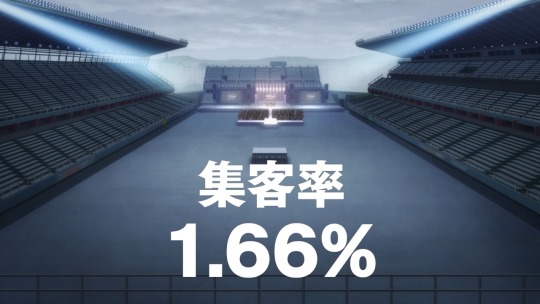
REVENGE: So this sequel begins with the girls doing odd-jobs trying to earn as much money as they possibly can. Normally, the girls would do odd gigs that Kotarou was able to conjure up and that’s been good publicity for their group Franchouchou. However, they came into some money problems when they gambled and lost. It’s no doubt that their performance in the 12th episode was a banger and gave Franchouchou a boost in the idol scene. However, they aimed too high by renting out a big amphitheater to have a concert and only 1.6% capacity was filled. So the performance that night was a crash and burn type of thing. The after-effect put the girls in the hole (money wise) and Kotarou spends his days getting drunk at bars.
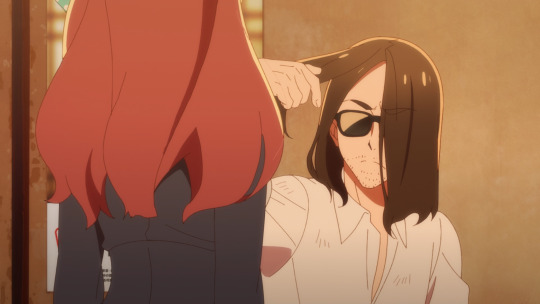
Seriously, look at this guy! He looks like a drunk, fourth season Eren Yeager. Kinda hard watching Kotarou looking so sad, pathetic, and drunk! It wasn’t until the girls had to perform at a metal concert arena that Kotarou got a kick in the pants. The fool arrives to the performance hella late, screaming for an encore when the audience is totally not vibing for one. And the girls end up singing while the audience goes in (for a lack of a better term) a Blues Brothers style rumble. The important thing is that Kotarou is feeling better and is ready to send his little zombie songbirds out to save the Saga prefecture.
Throughout the season, we follow the girls of Franchouchou as they regain some popularity they obtained last season. Will they do it? In the first 4 episodes, the group gained their own radio show and Ai’s old group (before she died) Iron Frill considered them as rivals. I think they’ll be okay!
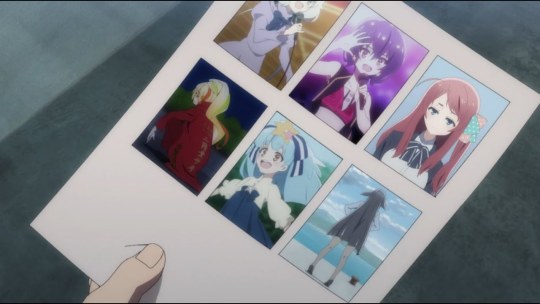
BUT WAIT…: What about that photographer fella we saw all last season? He was quickly catching onto Ai, Junko, and Lily looking a little too close in resemblance to the girls that died years ago. Slowly throughout the series, we see him get closer to the truth.
NEW IDOL?: Oh God, did Kotarou commit taboo once again by bringing another girl back from the dead?
No…It was sadly much worse.
While at a public bathhouse, a girl (not wearing her prescription glasses) entered the men’s side, slipped on some soap, and was knocked unconscious. Thinking she died, Kotarou brings her body back to the girls (who aren’t wearing their makeup) saying this girl will be #7 in Franchouchou. And just like I said, she is not dead and now she knows that the idol group she loves are dancing zombies.
Kotarou is truly fucking up royally this season.

Anyways, this is Maimai! She’s a fan of Franchouchou and ends up becoming a temporary member of the group as #7 (for the episode). And, she’s voiced by Kana Hanazawa! If you don’t know who she is by now, blow me. It’s a little scary knowing that there’s one person out there that knows about the secret. But Maimai is much too loyal a fan to ruin something for everyone and is totally chill about her favorite idol group really being zombies.
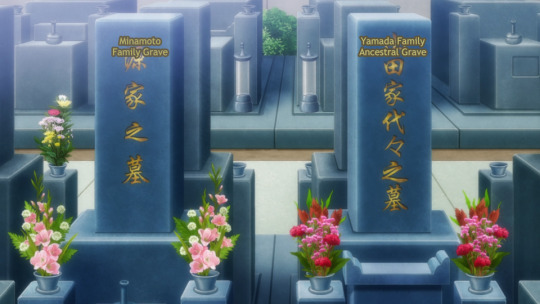
THE TWO UNSOLVED MYSTERIES: As much as many of us loved the first season to Zombieland Saga, there were two characters we wished got more play and we knew a little more about. Yugiri and Yamada Tae! Tae-chan has been the enigmatic idol from day one. And due to her possible mental disability, we might never know. However, in one episode we do see her stopping off at a cemetary and I do believe that was her own grave.
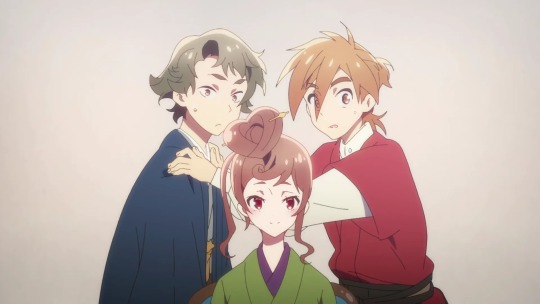
As for Yugiri, even the detective can’t dig up info on her. She was around in the late 1800s or the Meiji era and there’s only one known photo in existence of Yugiri before her death. This season, we got a two-episode saga to bring us the good word on Saga and its importance. We got a bit of a history lesson about the Saga prefecture during the Meiji era and even what it was like before then. And yes, we did learn how Yugiri died and her connection to Saga. It was quite sad, but definitely one of the best episodes of the series.
BEST SONG: Didn’t think I’d have one for this franchise.

Saga Jihen from episode 9.
Nuff said.
ENDING: Well, we learned some extra details on what happened during the fall and rise of Franchouchou. This mostly has to do with Kotarou’s gamble with booking a huge arena for the girls to perform in. First of all, this arena was the place of Ai’s death. You member! When she was electrocuted right there on stage! Second of all, they didn’t sell the tickets until the day of the concert. What was that end result again? 1.6% capacity filled! Even in Covid-19 times, that’s fucking small. Granted, the audience was full of those memorable fans from season one including Saki’s friend’s daughter, Lily’s father, and the two metal jackasses. But still, not a good! The girls hit a brick wall and felt embarrassed. This was the worst moment for these girls (aside from dying once). After the disasterous event, they were millions of yen in debt, they’re running out of essentials for the house, and Kotarou has gone on a two-month drinking binge. It was then that they decided to do makeup themselves and go out in the world to earn a living and eventually pay off the debt.
Thankfully, they were able to get out of debt and regained their popularity throughout Saga and further. Saki has managed to get a radio show. Iron Frill (Ai’s old group) sees Franchouchou as a worthy rival. Lily gained a lot of fame in a televised competition. So what’s next? Kotarou apologized to Franchouchou for his big mistake the previous year and him spiraling out of control. Seconds later, he announces that their revenge will be to perform at the very same arena that fucked up their career the year prior.
Boy, you do NOT learn your lesson, do you?!
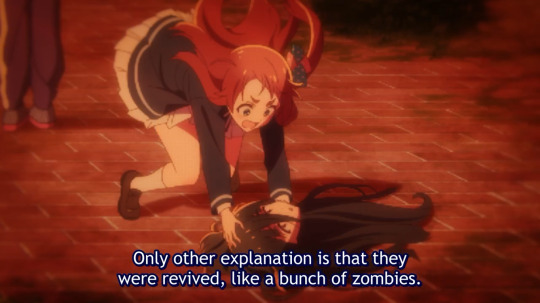
More trouble is on the rise as that reporter who caught on about the girls being zombies has confronted Kotarou. We finally circled back to the final scene from season one. This guy has caught on to the fact that the girls of Franchouchou resemble girls that died. The only one that he couldn’t dig up dirt on was Yugiri. Possibly because the only known evidence for existence is a photo at the bar! What’s more, he has a sneaking suspicion that the girls of Franchouchou are all zombies. In a prior episode, the reporter snapped a picture at the right time exposing Yamada Tae’s head rolling around on the ground. Dude is ready to go public with the story of the girls of Franchouchou being zombies resurrected from the dead unless Kotarou pulls the plug on everything. Kotarou simply said that the girls will get their revenge and will perform at the arena.
And then…a storm hit Saga!
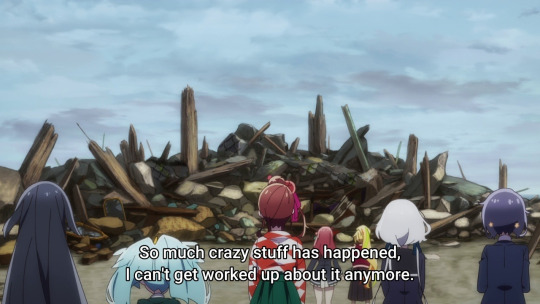
There was a lot of damage around town. And worst off was Kotarou’s place, as it was ripped from its foundation, thrown into the sea, and crumbled into nothing after coming ashore. Worst of all, the special makeup the girls use to hide their zombie state was in that wreckage. Meanwhile, Kotarou spent several days trapped in a bar with the bar owner and nearly drowned. The girls ended up in a safety shelter with nearly the entire Saga prefecture. The good thing is because they’re town celebrities that they were given a top floor to themselves for privacy. The bad thing is that they’ve been here for days and their makeup is starting to come off, exposing zombies. And to make matters worse, that nosy reporter who knows the girls are zombies is also staying at the shelter (though the girls don’t know he knows). The girls decided to use Junko’s doll-crafting paintset to make masks to hide behind. That lasted only five seconds while trying to entertain the children of the shelter.
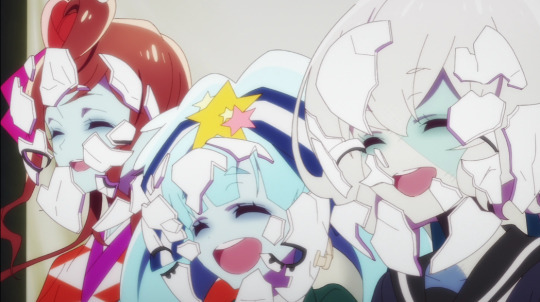
This is it. The girls are exposed as zombies.
Actually, the kids and parents thought this was part of the act and thought Franchouchou was lifting up the spirits of the arena. And in comes Kotarou just in time! Man, right under the wire. Now we’re like a few days from this planned concert and Saga is still recovering from the huge storm. Morale is quite low and it’s starting to look like a worse outcome for Franchouchou’s revenge than what happened one year ago. Saki used her platform on the radio to reach all of her viewers to see if they could try to come to the arena for their concert that is now a charity concert. So will this concert be a big success or a bigger flop than last year?
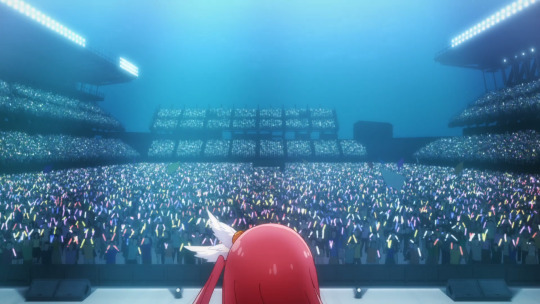
Actually, the arena was packed with people. Fans we’ve met in season one and new characters we met this season were even in attendance. Lily’s father ended up clearing away a lot of the debris so that concert goers could get through. Even Iron Frill (Ai’s old group) came in attendance! The concert was a huge success! And can I say that I’m really enjoying Yamada Tae’s Freddie Mercury impression on stage.
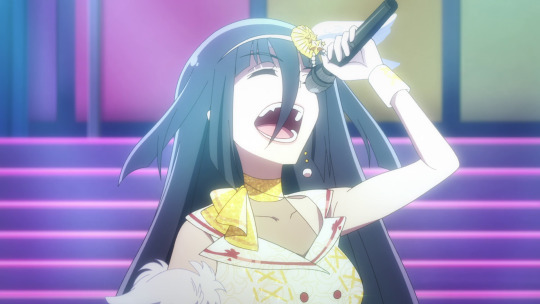
Don’t think you’re that clever, Zombieland Saga. We all know!
Yes, the concert was perfect! A great revenge! They even made Kotarou (a grown-ass man) cry. Even the reporter is willing to keep his trap shut (for now) about the girls being zombies. And best of all, NO ONE CAUGHT COVID-19! Yeah, I have to bring that up. The date of the concert was March 8th, 2020. Ahem. March. 2020. But yeah, everything went great. Perfect ending for Zombieland Saga Reven…
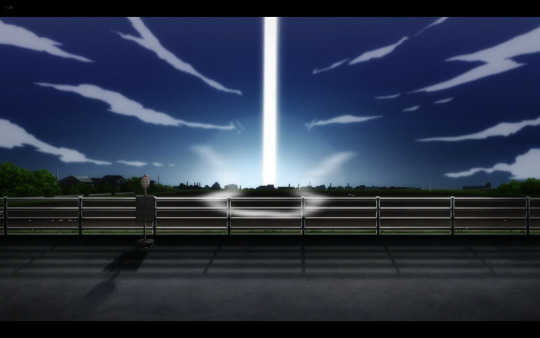
AND THEN AN ALIEN MOTHERSHIP COMES IN AND ZAPS THE AREA!
Huh?!
Who wrote that in the script? Some jerkass from Gainax?!
The last 15 seconds of Zombieland Saga leaves us with some sort of unidentified flying object zapping the area. Only Zombieland Saga can get away with this shit. Well folks, let’s see what’s in store for season three, Zombieland Saga: Zombies in Space or Sagapendence Day Zomb-Trek: Deep Space Seven.
Yeah, I know nothing has been greenlit or announced yet, but you know Studio Mappa has something up their sleeves with that ending. Once again, I enjoyed Zombieland Saga’s charm. I didn’t know if there was much more they could offer us after the first season’s stories, like learning how the girls died, Sakura’s past, and especially Lily’s backstory. This season, I wish there was more Yamada Tae. Come on guys, we still don’t know how she died or anything about her past! And what’s up with Yamada Tae being buried next to Sakura? Did they know each other before passing away? I want some answers! But I was blown away when it came to Yugiri’s saga and the tale of Saga itself. We got a literal history lesson about what Saga was once, what it became after a long struggle, the pain some folks went to in order to keep Saga thriving, and all leading up to where we are now.
This was a fun season. I had a lot more fun with the music this season than the previous one. Yeah, believe it or not I liked the songs Franchouchou sang this season than last season. Never a dull moment, especially with Kotarou! Yeah, his crazy-ass was totally there making absolutely no fucka sense. Take that competition Lily entered.

What the fuck was Kotarou doing? That was an epic fail on so many levels.
Well folks, whenever season three or whatever sequel may come, I’m hoping for more information involving Yamada Tae. And you know what else was severely missing from this season, Kotarou’s past with Sakura. I didn’t forget that flashback from season one and those couple of seconds this season aren’t enough to satisfy my hunger. Those are the two things I would like to know more about in whatever comes of the franchise. Otherwise, great time had by all!
Once more, if you are not a fan of idol shows, this is the only one I would highly recommend Zombieland Saga. Crunchyroll has both seasons available for streaming. FUNimation is now dubbing the second season as we speak.
#anime review#zombieland saga#zombieland saga revenge#yamada tae#kotarou tatsumi#saki nikaidou#sakura minamoto#junko konno#ai mizuno#yugiri#lily hoshikawa
5 notes
·
View notes
Link
Darren Criss acts as playwright when he writes songs. He’s far more confident, and certainly more vulnerable, when he allows himself to play the part. In such a way, songwriting opens up a whole new world that pulses with untapped potential. So much of what he has accomplished in 15 years resides in his willingness to expose himself to what his imagination and intuition have in store. He steps into a playwright’s shoes with considerable ease (just look at his resume), and always one to put on plenty of bravado, especially during our Zoom face-to-face, it’s the natural order of things.
“As I get older and write more and more songs, I really recognize that I’ve always preferred to write for another context other than my own,” Criss tells American Songwriter. He speaks with a cool intensity, gesturing emphatically to accentuate a sentence, and when you let him go, he’s like the Energizer Bunny 一 “I can tell by just how quiet you already are that you’re fucked,” he jokes at the start of our video chat. But he remains just as engaged and focused when listening.
He soaks in the world, taking astute notes about behavior and emotional traits he can later use in song. His storytelling, though, arrives already in character, fully formed portraits he can then relay to the world. It’s not that he can’t be vulnerable, like such greats as Randy Newman, Tom Waits, and Rufus Wainwright, who have all embroidered their work with deeply personal observations, it just doesn’t feel as comfortable. “I’ve always really admired the great songwriters of the world who are extremely introspective and can put their heart and soul on the chopping block,” he muses. “That’s a vulnerability that I think is so majestic. I’ve never had access to it. I’m not mad about it. It’s just good to know what your deal is.”
Criss’ strengths lie in his ability to braid his own experiences, as charmed as they might be, into wild, goofy fantasies. In the case of his new series “Royalties,” now streaming on Quibi, he walks a fine line between pointed commentary on the music industry, from menial songwriting sessions to constantly chasing down the next smash, and oddball comedy that is unequivocally fun. Plotted with long-standing friends and collaborators Matt and Nick Lang, co-founders of Team StarKid, created during their University of Michigan days (circa 2009), the show’s conceptual nucleus dates back more than a decade.
If “Royalties” (starring Criss and Kether Donohue) feels familiar, that’s because it is. The 10-episode show ─ boasting a smorgasbord of delightful guest stars, including Mark Hammill, Georgia King, Julianna Hough, Sabrina Carpenter, and Lil Rel Howery ─ captures the very essence of a little known web series called “Little White Lie.” Mid-summer 2009, Team StarKid uploaded the shoddy, low budget production onto YouTube, and its scrappy tale of amateur musicians seeking fame and fortune quickly found its audience, coming on the heels of “A Very Potter Musical,” co-written with and starring Criss. Little did the trio know, those initial endeavors laid the groundwork for a lifetime of creative genius.
“It’s a full circle moment,” says Criss, 33, zooming from his Los Angeles home, which he shares with his wife Mia. He’s fresh-faced and zestful in talking about the new project. 11 years separate the two series, but their connective thematic tissues remain striking. “Royalties” is far more polished, the obvious natural progression in so much time, and where “Little White Lie” soaked in soapy melodrama, the former analyzes the ins and outs of the music world through more thoughtful writing, better defined (and performed) characters, and hookier original tunes.
“Royalties” follows Sara (Donohue) and Pierce (Criss), two struggling songwriters in Los Angeles, through various career exploits and pursuits. The pilot, titled “Just That Good,” features an outlandish performance from Rufus Wainwright as a major player in dance-pop music, kickstarting the absurdity of Criss’ perfectly-heightened reality. As our two main characters stumble their way between songwriting sessions, finally uncovering hit single potential while eating a hot dog, Criss offers a glimpse into the oft-unappreciated art of songwriting.
In his own songwriting career ─ from 2010’s self-released Human EP and a deal with Columbia Records (with whom a project never materialized) to 2017’s Homework EP and Computer Games’ debut, Lost Boys Life, (a collaboration with his brother Chuck) ─ he’s learned a thing or two about the process. Something about sitting in a room with someone you’ve never met before always rang a little funny to him.
“You meet a stranger, and you have to be creative, vulnerable, and open. It’s speed-dating, essentially. It’s a different episode every time you pull it off or not. All the big songwriters will tell you all these crazy war stories. Everyone has a wacky story from songwriting,” he says. “I slowly realized I may ─ I can’t flatter myself, there are tons of creative people who are songwriters ─ have prerequisites to just put the two together [TV and music]. I’ve worked enough in television as an actor and creator. I can connect the dots. I had dual citizenship where I felt like it was really time for me to go forth with this show.”
But a packed professional life pushed the idea to the backburner.
Between six seasons of “Glee” (playing Blaine Anderson, a Warbler and lover to Chris Colfer’s Kurt Hummel), starring in “Hedwig and the Angry Inch” on Broadway, and creating Elsie Fest, a one-day outdoor festival celebrating songs of the stage and screen, he never had the time. “I was lucky enough to be busy,” he says. “As Team StarKid’s star was continuing to rise with me being separate from it, I was trying to think of a way to get involved again with songwriting.”
At one point, “Glee” had officially wrapped and his Broadway run was finished. It appeared “Royalties” may finally get its day in the sun. “I went to Chicago for a work pilgrimage with the Langs. We had a few days, and we put all our ideas on the map: every musical, feature film, show, graphic novel, and animated series we’ve ever thought of,” he says. “A lot of them were from the Langs; they were just things I was interested in as a producer or actor. We looked at all of them and made a top three.”
“Royalties” obviously made the cut.
Fast forward several years, Gail Berman’s SideCar, a production company under FOX Entertainment, was looking to produce a music show. Those early conversations, beginning at an otherwise random LA party, showed great promise in airlifting the concept from novel idea to discernible reality. Things quickly stalled, however, as they often do in Hollywood, but Criss had at least spoken his dreams into the universe.
“I finally had an outlet to put it into gear. It wasn’t until two to three years after that that things really locked in. We eventually made shorts and made a pilot presentation. We showed it to people, and it wasn’t until Quibi started making their presence known that making something seemed really appealing,” he says. “As a creator, they’re very creator-centric. They’re not a studio. They’re a platform. They are licensing IP much like when a label licenses an indie band’s album after the fact.”
Quibi has drawn severe ire over the last few months, perhaps because there is a “Wild Westness” to it, Criss says. “I think that makes some people nervous. Being my first foray into something of this kind, Quibi felt like a natural partner for us. If this had been a network or cable show, we would’ve molded it to be whatever it was.”
Format-wise, “Royalties” works best as bite-sized vignettes, charming hijinks through the boardroom and beyond, and serves as a direct response to a sea of music shows, from “Nashville” and “Empire” to “Smash.” “Those shows were bigger, more melodramatic looks at the inside base of our world. I’ve always been a goofball, and I just wanted to take the piss out of it,” he says. “This show isn’t about songwriting. It’s about songwriters… but a very wacky look at them.”
“30 Rock,” a scripted comedy loosely based around “Saturday Night Live,” in which the focus predominantly resides around the characters, rather than the business itself, was also on his mind. “It’s about the interconnectivity of the people and characters. As much of the insider knowledge that I wanted to put into our show, at the end of the day, you just want to make a fun, funny show that’s relatable to people who know nothing about songwriting and who shouldn’t have to know anything.”
Throughout 10 episodes, Criss culls the “musicality, fun, and humor” of Fountains of Wayne’s Adam Schlesinger and Max Martin, two of his biggest songwriting heroes, and covers as many genres as possible, from K-Pop to rap-caviar and classic country. While zip-lining between formats, the songs fully rely on a sturdy storytelling foundation ─ only then can Criss drape the music around the characters and their respective trajectories. “I wanted to do something where I could use all the muscles I like to flex at once, instead of compartmentalizing them,” he says. “I really love writing songs for a narrative, not necessarily for myself. I thrive a little more when I have parameters, characters, and a story to tell.”
Bonnie McKee, one of today’s greatest pop architects, takes centerstage, too, with an episode called “Kick Your Shoes Off,” in which she plays a bizarro version of herself. “She has her own story, and I’ve always been fascinated by it,” says Criss, who took her out to lunch one day to tell her about it. Initially, the singer-songwriter, known for penning hits for Katy Perry, Taio Cruz, and Britney Spears, would anchor the entire show, but it soon became apparent she would simply star in her own gloriously zany episode.
In one of the show’s standout scenes, Pierce and Sara sit in on a label meeting with McKee’s character and are tasked with writing a future hit. But they quickly learn how many cooks are in the kitchen at any given moment. Everyone from senior level executives to publicists and contracted consultants have an opinion about the artist’s music. One individual urges her to experiment, while another begs not to alienate her loyal fanbase, and then a third advises her to chronicle the entire history of music itself ─ all within three minutes or so. It’s absurd, and that’s the point. “Everyone’s been in that meeting, whether you’re in marketing or any creative discussion that has to be made on a corporate level by committee. It’s the inevitable, comedic contradictions and dissociations from not only rationality but feasibility.”
Criss also draws upon his own major label days, having signed with Sony/Columbia right off the set of “Glee,” as well as second-hand accounts from close friends. “There are so many artists, particularly young artists, who famously get chewed up and spat out by the label system,” he says. “There’s a lot of sour tastes in a lot of people’s mouths from being ‘mistreated’ by a label. I have a lot of friends who’ve had very unfortunate experiences.”
“I was really lucky. I didn’t have that. I have nothing but wonderful things to say,” he quickly adds.“It wasn’t a full-on drop or anything. I was acting, and I was spreading myself really thin. It’s a record label’s job to make product, and I was doing it piecemeal here and there. I would shoot a season [of ‘Glee’] and then do a play. I was doing too many things. I didn’t have it in me at the time to do music. I had written a few songs I thought were… fine.”
Both Criss and the label came to the same conclusion: perhaps this professional relationship just wasn’t a good fit. They parted ways, and he harbors no ill-will. In fact, he remains close friends with many folks from that time. So, it seems, a show like “Royalties” satisfies his deep hunger to make music and write songs ─ and do it totally on his own terms.
“I still say I want to put out music, and fans have been very vocal about that. I feel very fortunate they’re still interested at all,” he says. “That passion for making music really does come out in stuff like [this show].”
“Royalties” is Darren Criss at his most playful, daring, and offbeat. It’s the culmination of everything he has tirelessly worked toward over the last decade and a half. Under pressure with a limited filming schedule, he hits on all cylinders with a soundtrack, released on Republic Records, that sticks in the brain like all good pop music should do. And it would not have been the same had he, alongside Matt and Nick Lang, not formed Team StarKid 11 years ago.
Truth be told, it all began with a “Little White Lie.”
68 notes
·
View notes
Text

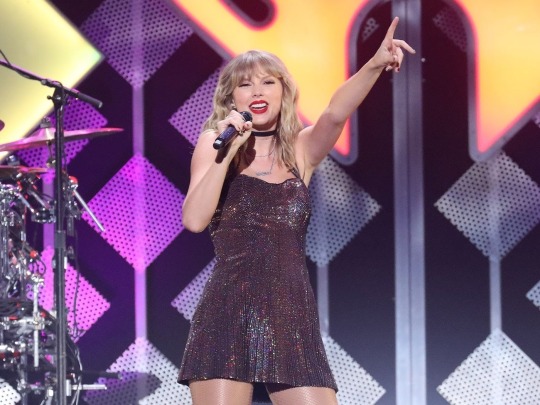
Taylor Swift is the millennial Bruce Springsteen.
If there were any doubts about this, they should have been dispelled by her latest release: the haunting Folklore, which filters the exact kinds of story-songs Springsteen excels at through Swift’s modern, orchestral-pop aesthetic. The album has been one of the best-received of her career, but then, the response to essentially everything she’s produced since her 2010 album Speak Now has involved critics grudgingly being dragged toward having respect for her skills.
The overlaps between millennial Swift (30 and born in 1989) and baby boomer Springsteen (70 and born in 1949) — both of whom are among the best songwriters alive right now — are considerable beyond their songwriting prowess. But comparisons, by necessity, must start there.
Both musicians love songs about a kind of white Americana that’s never really existed but that the central characters of which feel compelled to chase anyway. They use those songs to tell stories about those people and the places they live. They’re terrifically good at wordplay. Both are fascinated by the ways that adolescence and memories of adolescence continue to have incredible power for adults. Both are amazing at crafting bridges that take already good songs to another level. And both write songs featuring fictional people whose lives are sketched in via tiny, intimate details that stand in for their whole selves.
For example: The opening lines to Springsteen’s “Thunder Road” (“The screen door slams / Mary’s dress waves / Like a vision she dances across the porch / as the radio plays”) tell you everything about that woman and the man observing her.
Similarly, the opening lines of Swift’s “All Too Well” (“I walked through the door with you, the air was cold / but something ‘bout it felt like home somehow and I / left my scarf there at your sister’s house / and you still got it in your drawer even now”) tell you everything about this doomed relationship and the nostalgia both people involved in it still feel, compressed into a tiny little stanza.
Springsteen released “Thunder Road” when he was 25; Swift released “All Too Well” when she was 22. Both songs continue to stand as touchstones for who the artists were at that point in their lives.
But leave this comparison aside for a moment. What’s most interesting about drawing this connection are the ways in which the overlap between Springsteen and Swift’s styles can tell us about how our culture treats art made by men versus art made by women — and art made by baby boomers versus art made by millennials.
Springsteen and Swift each entered the music industry as young wunderkinds with lots to prove. Springsteen’s first album — the loose and rambling Greetings from Asbury Park, N.J. — was released when he was just 23. He had been playing in bands all around New Jersey for most of his teens, and signed a record deal with Columbia Records at 22.
He was expected to become an acoustic folk singer in the vein of Bob Dylan, at a time when the music industry was uniquely preoccupied with finding the “next” Bob Dylan. Springsteen quickly flaunted those expectations, assembling a group of musicians who would go on to be known as the E Street Band, in the name of creating a sound that captured a massive, orchestral blast of rock. Springsteen would finally perfect this sound on his third album, 1975’s Born to Run, and he’s been a global superstar ever since, even decades after reaching his pinnacle with 1984’s Born in the USA.
Swift’s rise was slightly more meteoric. She released her debut album, Taylor Swift, when she was just 16, and it featured songs that she had written as a freshman in high school. Swift broke into the industry via country music, and her country-ish second album, 2008’s Fearless, won her the Grammy for Album of the Year.
Just as Springsteen shirked folk in the name of rock, Swift’s sound quickly shifted away from the girl-with-a-guitar country archetype and more toward pop. By her fourth album, 2012’s Red, she had largely left country music behind.
(A fun game: If you line up Swift and Springsteen’s album releases roughly by how old they were when they recorded them, you’ll find surprisingly similar career trajectories. For instance, Born to Run and Swift’s 2014 album 1989 were released when their respective artists were 25. Both broke the artists through to even wider acclaim than they had before.)
Yet the two artists’ backgrounds are quite different, which may explain the different ways in which they’ve understood American political divides. Springsteen grew up in a blue-collar family in New Jersey, while Swift is the daughter of a former Merrill Lynch stockbroker who could afford to move the entire family to Nashville, Tennessee, when his daughter showed a talent for songwriting.
Springsteen’s songs have always reflected growing up in a world where poverty is just a lost paycheck away, even as he’s become incredibly rich. Swift has no such perspective. Her songs take place largely in a wistful world where money is rarely an object. And the artists came of age in very different political climates, too.
But the political divide has narrowed in recent years. Swift has taken a recent turn toward more political topics — particularly social justice issues involving the mistreatment of women and LGBTQ rights. That turn stems from her struggles to differentiate herself as an artist in an industry that routinely turns young, beautiful women into disposable products, wringing out of them a few years of hit singles and then tossing them aside. Her embrace of the ways her growing sense of (extremely white) feminism helped her attain more artistic control over her image has slowly but surely led to a greater understanding of the yawning disparities inherent to the US. She is more tapped into the ways that power is unequally distributed throughout American society and increasingly speaks out to that effect. (She’s still pretty lousy at confronting class issues, though.)
But even with all of their similarities as songwriters and increasing similarities as explicitly political artists — and even with all of the awards they have won and records they have sold — there’s still a knee-jerk insistence that Swift is either too self-obsessed or too much a creation of the music industry, while Springsteen went from being rock’s heir apparent to an elder statesman with only a few bumps along the way. And the reasons for that disparity go well beyond any artistic differences or similarities they might possess.

The most obvious difference between the reception of Springsteen and Swift is also the most obvious difference between the two of them as people: He is a man, and she is a woman.
Swift didn’t exactly discourage listeners from constantly parsing her lyrics to figure out which of her famous exes she was singing about early in her career; she even hid hints in her liner notes to help fans decode her clues. But the degree to which she was written off, for years, as a fundamentally unserious and self-involved artist reflects the ways in which domestic and romantic concerns are written off as unimportant when women talk about them.
By comparison, Springsteen has so many songs about teenage boys crushing on teenage girls, but few people try to figure out who he’s talking about when he mentions the almost mythical “Mary” in songs throughout his career. Perhaps it’s because he wasn’t dating famous people as a teenager, and perhaps because it’s sadly still too common to think a man singing about an adolescent crush has more artistic merit than a woman doing the same thing.
Even in the wake of Folklore’s release, many corners of the music-discussing internet insist upon talking about the album more in terms of Swift’s male collaborators — namely Aaron Dessner of The National and Justin Vernon (a.k.a. Bon Iver), both indie-rock royalty — than in terms of her own talents, even when, say, Dessner does a whole interview with Pitchfork talking extensively about Swift’s preternatural songwriting talents. The idea that Taylor Swift has somehow been “created” by someone is one that seems to persist, regardless of how much control she has over her own image.
But the ways in which people doubt Swift’s talent, or her control over her image, reflect larger questions about how baby boomers remade pop culture in their image versus how millennials continue to do.
Baby boomers were born into the era of radio’s dominance over American airwaves, and television entered their lives during their childhoods. The presence of these mass media influenced how much pop culture boomers could be exposed to, pushing into hyperdrive the artistic loop of influence becoming creation. American popular art exploded and proliferated as a result.
Whether that explosion led to the rise of rock and pop music or the invention of the cinematic blockbuster, baby boomers took the popular forms their parents adored and accelerated them toward something more raucous and purely entertaining.
The dominant new medium of millennials’ lives was the internet, which arrived when we were still very young. And a major element of internet culture is remix culture. From the earliest days of the “information superhighway,” jokes that mashed up disparate elements of pop culture — now we’d call them memes — were incredibly common, because the central idea of the internet has always been many people iterating on an idea rather than one person releasing that idea into the world.
Inherent to this kind of remixing is the idea of transforming something, often something disreputable, into something else. Thus, many of the greatest millennial artists work in forms that have previously been written off as unworthy — like, say, pop music — because the gatekeepers in those areas weren’t as likely to be aging baby boomers whose taste was ossifying. (This progression is not all that dissimilar from what the boomers did to the popular culture they were born into.)
Millennial artists grew up amid the splintering of the monoculture and, therefore, feel less of an obligation toward it than older generations might. When all you’ve known are niches, it’s better to try to find a niche that appeals to you and explore it as much as possible, then hope enough people come along for the ride.
Swift’s eagerness to collaborate with other artists who really excite her isn’t a uniquely millennial trait: Artists have been doing this since artists have existed. That she is only too happy to spread that credit around (even as her increasingly well-known “voice memos” that show her coming up with the central ideas behind her songs center her authorship first and foremost) is a testament to how millennial artists feel comfortable with both celebrating their influences and revealing how their art gets built, brick by brick, often thanks to the work of other people.
This is not to say that all baby boomer or millennial artists operate exactly the same way as Springsteen or Swift. Both artists write music that is equal parts heartbreaking and fun, evocative, and ephemeral. They’re constantly searching for their version of an America that does not exist, while not forgetting to make sure that we all have some fun in the one that does.
The impulse they share to tell stories about average Americans searching for meaning amid a crumbling world is a natural one for artists in the US. Yet Springsteen has so often been celebrated for doing just that, his rugged vision of a fading nation and talent for making national crises deeply personal treated as authentic and brilliant.
By comparison, Swift is often derided for how she digs into the ways personal apocalypses visit themselves onto the rest of reality, making her something like Springsteen’s inverse. The struggles she faces are deeply rooted in biases against women, the genre of music she operates in, and her generation. It’s worth reexamining the notions that drive this disparity in the two artists’ reception, if nothing else.
Perhaps we take Springsteen more seriously than Swift because he’s a man, or because all the great rockers of his generation have been venerated by time and nostalgia, or because his influences were men like Chuck Berry and Woody Guthrie instead of Shania Twain, Patsy Cline, and a litany of contemporary collaborators. But one of art’s great pleasures is finding the ways in which artists of different generations talk about the same topics across the span of years.
Bruce Springsteen and Taylor Swift craft their impeccable story-songs utilizing the tropes of very different musical genres. But they’re equally good at crafting songs built to both sing loudly on the freeway and accompany a flood of tears in the wake of some new heartache. Different as they might be, Springsteen and Swift are always talking about the same thing — all of the ways that every new day, no matter how promising, carries within it the potential to bring about the end of the world all over again. Until then, though, let’s sing about it.
ts1989fanatic all of that just to Tell us something swifties have known for years, the music industry is sexist and misogynistic DUH!!!
25 notes
·
View notes
Text
10 Underrated Movies of the 2010s
1. John Carter (2012)

Before Snow White and the Seven Dwarves was even produced in 1937, Disney was considering producing an adaptation of Edgar Rice Burrough’s A Princess of Mars as Disney’s first animated film. During its pre-production stage, producers weren’t quite receptive to the concept. The story was about a man being transported to Mars, where its gravity gave him super powers, and he fought with four-armed green-skinned aliens. Back then, space ideas were the last things on people’s minds in the ‘30’s. They wanted something uplifting from The Great Depression.
Disney didn’t quite scrap the story; they shelved it for later and decided to go with Snow White and the Seven Dwarves as Disney’s (and the world’s) first feature-length animated movie. John Carter holds the award for the movie with the longest time spent in “development hell”. For the next 75 years, different directors and producers would try to bring back the classic tale of daring-do on the planet Mars. Growing up reading Edgar Rice Burrough’s novels, I was enthralled to hear that they finally produced a live-action film to be released on 2012 – and it was even near my birthday! March of 2012 marked 100 years since Edgar Rice Burroughs published A Princess of Mars. It was like all the stars were truly aligned for something great.
The movie finally came out and it . . . didn’t do well at all. It’s also notable for being one of the most expensive movies ever made – and it was all for nothing.
What happened?
Most of you reading this may even be unaware of the hero John Carter or A Princess of Mars. I find that the main issue was the problem of John Carter being largely unknown because it has been long overshadowed by Flash Gordon, Superman, Star Trek, Star Wars, Battlestar Galactica, and literally everything else that owes its inspiration to John Carter.
Superman got its concept of gravity-granting superpowers from John Carter. Flash Gordon got its human-on-another-planet heroics from John Carter. Star Wars derived nearly everything from Flash Gordon. The domino effect goes on. The further you go, the more people forget the original inspiration, and we live in a world now where people don’t really care about who did it first, but who did it best.
There’s a particular scene in the movie John Carter where the titular hero has to fight monsters in an arena. Many critics were bored of the scene, claiming they saw it already in Star Wars Episode II: Attack of the Clones; which is ironic being that the arena scene was written almost a full century before Attack of the Clones. Scantily clad Carrie Fisher in Return of the Jedi? That’s a Deja Thoris reference from A Princess of Mars.
It can be difficult to judge a movie or story by itself aside from other derivative works. When that source material is some obscure adventure tale that is literally older than World War I, you should realize that probably not a lot of people have heard about it nowadays.
The film suffers from two other major points: the runtime and the combination of books one and two of Burrough’s original trilogy. A Princess of Mars is a rather simple tale of a man saving a princess on Mars. Its sequel, The Gods of Mars, goes into more complex matters as the evil Therns are revealed as a group of mysterious aliens controlling all culture and life on Mars for their benefit. The movie John Carter tries to combine the two, and I see why. Modern audiences are uninterested in seeing another adventure tale about a guy saving a princess. Ironically, that would have worked much better in the 1930’s, but the Disney board at the time was like, “Space? What’s that? Mars? What’s this newfangled spaceship business?”
John Carter ultimately had the unfortunate and unique experiences of being both too ahead and too dated for its time.
I still highly recommend it because the production value is amazing and it’s still highly entertaining. The score is fantastic (Michael Giacchino), and the performances are great, albeit with some cheesy dialogue. The screenwriters added more depth to the character of John Carter that really pulls some heartstrings, especially during one particular scene where he’s bashing hundreds of aliens to a pulp.Unfortunately, the poor performance of John Carter prevented its sequel and the planned trilogy from ever being produced. At the end of the day, I’m still content with seeing the world’s very first space adventure that ultimately inspired Star Wars finally put on screen.
2. Solo: A Star Wars Story (2018)

I was frankly surprised when nobody else cared about a Solo movie coming out. Having read A.C. Crispin’s Han Solo Trilogy when I was a kid and having overall grown up loving the character, I thought ANY Star Wars fan would be pumped. That was the issue right away before the movie even hit theaters – Nobody. Fucking. Cared. The previous year’s Last Jedi left a sour, divisive taste in the Star Wars fandom. Toxic fans threw their hands in uproar and an entire debacle unseen since the prequel trilogy exploded. Like with Jake Lloyd in The Phantom Menace, fans had continually harassed and bullied Kelly Marie Tran for playing Rose to the point where she quit Instagram. YouTube videos nearly 30 minutes long were dedicated to bashing the film and “SJW culture” and “virtue signaling”. The entire debacle was a nightmare that makes me shudder to even think about. It was like everyone was tired of Star Wars by the next year.
Some people like to say that “Star Wars fatigue” wasn’t the thing because nobody was tired of Marvel movies. I disagree. First of all, I witnessed immediate responses to people’s reactions at the trailer. They said “I don’t care” and “Why do we need that?”. Second, Star Wars and Marvel are two completely different universes. Marvel has a nearly infinite range of various stories with various atmospheres and moods and characters. One Marvel fan can “specialize” in Doctor Strange while another mostly loves Thor. Star Wars follows the same group of characters over the same damn story that we’ve already known for the past 42 years.
Like John Carter, Solo had the same problem by being too confident and throwing too much money into its production. Solo also happens to be on the list of the most expensive movies ever made. Its poor performance and inability to make a return on the total costs scrapped the possibility of any more future standalone Star Wars films.
Further dissections of why it didn’t work out vary. Some people hate the droid L3-37 and claim unnecessary SJW content. I disagree with that too. In my rulebook, something in a story is not unnecessary unless it proves crucial to the plot; L3-37 is the reason why the Kessel Run worked. Were it not for her fanatic desire of starting a droid revolution, Han wouldn’t have survived. The idea of revolution is also crucial and foreshadows the coming Rebel Alliance. I wonder if people would have had the same reaction to L3-37 if the movie had been released years before the current political situation; if we would have just seen her as a cool, kooky and rebellious droid instead.
Solo: A Star Wars Story reveals that Han has always been around instances of rebellion, which he has tried to ignore. It isn’t until A New Hope that he finally gives in for good. I honestly don’t see why some people say it doesn’t fit with A New Hope when it clearly does. One of my favorite parts is when Q’ira tells Han, “I know who you really are.” From the trailer, you would expect her to say “A scoundrel.” But in the film, she says, “The good guy.” The film cements the idea that Han has always tried to look and act cool but deep down he gives in to doing the right thing, which separates him from the other scoundrels at the cantina. It’s because of this adventure that he ends up helping to blow up the Death Star later on.
Also, like John Carter, the score is absolutely fantastic. I could go on about it but that would derail the topic for another time.
3. The Gift (2015)

I ended up seeing this movie on a whim by myself after someone bailed on me at the last minute to hang out. I had nothing to do but wanted to do something and checked what was playing in theaters at the time at my local theater. The synopsis hadn’t told me enough about what was really going on while at the same time enticing me.
Jason Bateman though really surprised me in this role.I really don’t want to give anything away other than what you can find on the basic synopsis. Jason Bateman is married to Rebecca Hall and the two share a completely content life, until an old school friend of Jason’s starts visiting them. Joel Edgerton plays the school friend, and it’s quite amazing that he both wrote and directed this film too.
4. Prisoners (2013)

This movie was great – and absolutely nobody talks about it. I recall wanting to see a movie with my mom around fall of that year. We realized there was really nothing interesting in theaters. It was a lull where there was nothing really interesting playing. No blockbusters and no Oscar buzz. We chose Prisoners solely based on the fact that we like Hugh Jackman and Jake Gyllenhaal, and I guess we also gathered the general sense that it was a mystery.I became glued to the screen during the entire movie.
The story revolves around Hugh Jackman’s daughter supposedly abducted by Paul Dano, who plays a mentally ill suspect. Jake Gyllenhaal plays the detective tasked with finding the daughter. With Paul Dano being unable to articulate his thoughts, everyone is left distraught on how to solve this case. Hugh Jackman and Jake Gyllenhaal take drastically different routes in trying to find the girl.Out of everything on my list of underrated films here, this was the most nail-biting. Highly recommend. That ending. Whoo.
5. Source Code (2011)

This movie is a real mindbender. It might be so much of a mindbender that it’s the reason why people didn’t talk about it more. They probably just thought, “Huh?” and wanted to rewatch the previous year’s Inception again instead.Jake Gyllenhaal is on a mission to find a bomber on a train in a computer simulation. That’s how it starts at least. . .
Another movie I probably shouldn’t explain too much, but it explored themes about a post 9/11 world and the nature of self.
6. The Big Short (2015)

This movie was a hit and then everybody forgot about it. Heck, I know a bunch of you didn’t even see it. I find this really concerning. Brought to you by the director of none other than Anchorman, Adam McKay directed a very entertaining but distressing take on the Great Recession. It has an ensemble cast of Brad Pitt, Steve Carrell, Ryan Gosling, and Christian Bale.
The movie manages to translate complicated, bullshit concepts in Wall Street into layman’s terms. Every performance delivers, yes, but it was also staggeringly prophetic in what would come a year later in the 2016 election – “I have a feeling, in a few years people are going to be doing what they always do when the economy tanks. They will be blaming immigrants and poor people.”
This movie should have seriously started a riot. But it didn’t. Watch it.
7. Spectre (2015)
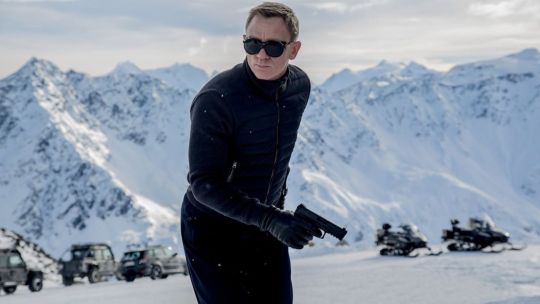
Many Bond fans hated Spectre, and it’s often compared to the supposed high-and-mighty Skyfall. I beg to differ. Spectre brought back the fun in Bond without also resorting to the really obnoxious misogyny. The Daniel Craig era of Bond films went back to Ian Fleming’s original intention of Bond being more of a “blunt instrument” than the tongue-in-cheek action hero he came to be known in the film series. And that’s okay. But you can’t help but be bored once and a while by the recent trend of “making things gritty in the new millennium”. Spectre brought back the evil Blofeld, Bond’s nemesis. Fans hated it because this movie implies that every other Daniel Craig movie has been tied to Spectre, ruining the standalone nature of Skyfall and feeling like Spectre was a shoe-in.
This situation requires a lot of explaining, but I’ll be brief.
The creative entities of Spectre and Blofeld were tied up in a copyright battle for almost half a century. Back when Ian Fleming was still alive, he was working on a script for Thunderball with a screenwriter named Kevin McClory. Long story short, there was a dispute on who created Spectre and Blofeld – Fleming or McClory. McClory won the dispute and MGM (the producers of the Bond films) were prohibited from using the names and characters of Spectre and Blofeld.
The last time we officially saw the character in name was in 1971’s Diamonds are Forever. Blofeld made a cameo in 1981’s For Your Eyes Only but was never mentioned by name, but you knew it was Blofeld because he was always the man with the white cat. McClory did eventually make his own version of Thunderball in 1983’s Never Say Never Again, which was an unofficial Bond movie yet it still starred Sean Connery (crazy, I know).
Fast-forward to when the Daniel Craig era started in 2006 with Casino Royale. Spectre and Blofeld were still under copyright protection of McClory. Instead of using the name Spectre, the writers had to come up with another Specter-inspired evil corporation. So they came up with “Quantum”, the evil company behind the plots of Casino Royale and Quantum of Solace.
BUT THEN, the McClory estate officially settled the matter with MGM in 2013, and Spectre and Blofeld could now be used. The writers jumped on it and that’s why to some Spectre feels like it was a shoehorned at the last minute.In my opinion, Skyfall had more issues being a standalone film. The villain Silva was supposed to be working alone and yet somehow create all these elaborate, time-sensitive plots that was just too much for one man with maybe a few henchmen to pull off. In Spectre, it’s implied that Silva used Spectre’s resources to help him plan his revenge. This would realistically make more sense. After all, it’s in the name: SPecial Executive for Counter-intelligence, Terrorism, Revenge, and Extortion. One would go to Spectre in order to enact revenge on someone if one didn’t have the means or resources.
And the whole Quantum being a part of Spectre thing – so what? Quantum was meant to be the same thing anyway. Lastly, there is some dispute on to the nature of Blofeld’s relationship with Bond. Bond suddenly has an evil foster brother now? Some complained about it. I thought it was fine. It gives a reason for Blofeld to go out of his way to torture Bond rather than just shoot him, which is a point always parodied in Bond spoofs. So again, it actually makes sense.
I thoroughly enjoyed Spectre. It was virtually not misogynist out of the new Bond films. It treated the main girl, Madeline, very well, as well as the “other” girl Lucia. Yeah, some of the action is dumb and more out of spectacle than realism. It’s still done with the same wit and style of the old Bond films.
8. Shazam! (2019)

Yeah. I get it. Everyone’s tired of the god-awful, insipid DC Cinematic Universe (except for Wonder Woman), which pales in comparison to the Marvel Cinematic Universe. But Shazam! was finally a very fresh, funny, and lively DC movie. What makes it stand out to me was how it ended up revolving around the main character’s friends standing together with him, rather than just simply being an origin story of one superhero. Nothing felt like it fell flat. The humor was spot on. The action was good. You had a really pained, terrible villain. Some of the plot may be simple but it had a satisfying ending. Shazam! has the same kind of energy as Spider-man: Homecoming, but by doing its own thing and having its own theme of what a family really means. It revels in the genre by literally putting you in the shoes of a child’s wish fulfillment.
9. Safety Not Guaranteed (2012)
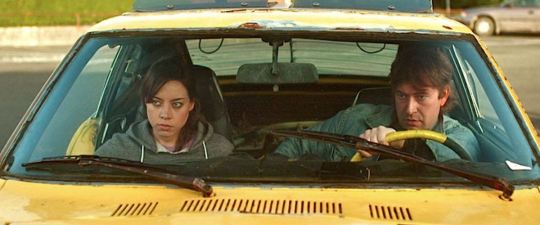
I saw this movie on a whim on Netflix. Nobody has made any fuss about it. I think it was fantastic. It’s a quirky sci-fi comedy with Aubrey Plaza playing a newspaper reporter investigating an ad someone put in the classifieds asking for a time travel companion. She goes along with two other co-workers, played by Jake Johnson and Karan Soni (who later becomes the taxi guy in Deadpool). I have to be honest – I don’t find Jake Johnson that funny. In most things I’ve seen him in, I feel like his reactions are forced. But his deadpan deliveries in this movie are on the spot. Mark Duplass was still relatively unknown at this time, and played the oddball guy who placed the ad and firmly believes he made a time machine.
The entire movie only costed $750,000! Movies today need to spend over $10 million in order to try and make something as compelling as this. This movie alone influenced the modern indie film industry by combining forces with Netflix. Maybe Netflix and chill wouldn’t have been a thing if it weren’t for this movie.
10. The Nice Guys (2016)

I saved my personal favorite for last. The Nice Guys is my favorite underrated movie that I have seen this past decade. It has everything I love in a buddy film; wit and style. Written and directed by Shane Black, this movie has some real zingers and hilarious deliveries. Ryan Gosling plays a jittery private detective, who unwillingly teams up with Russel Crowe, who beats up people for a living.
The story revolves around a missing girl who is a key witness to a grander conspiracy involving the automobile industry. This is one of those movies that never fails to make me laugh. I can rewatch the same scenes over and over and still crack up with laughter. My only gripe is that the final confrontation can be a bit unrealistic at times, which can be close to breaking that border of “Okay, is this witty satire like Coen Brothers or just outright comedy sketch like The Naked Gun?” So to me it felt a little imbalanced in the last quarter. Still, the rest of the movie really hits the right marks.
#ryan gosling#john carter#movies#theaters#brad pitt#steve carrell#sci-fi#movie#onmovies#film#oscars#shazam#shazam!#james bond#spectre#ian fleming#aubrey plaza#star wars#solo: a star wars story#solo movie#han solo#prisoners#edgar rice burroughs#barsoom#mars trilogy#a princess of mars#pulp fiction#disney#unederrated
72 notes
·
View notes
Text
Ranking : The Coen Brothers (1954/1957 - present)
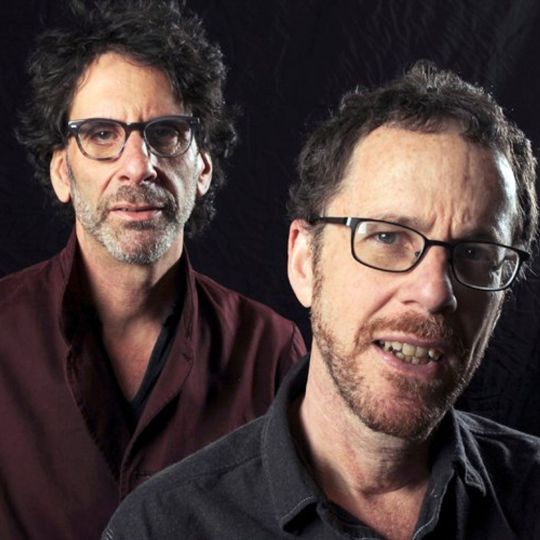
Directing a film can be one of the most vast, task oriented and stress inducing undertakings imaginable, which makes it odd that more directing duos, specifically sibling duos, do not exist. Sibling duos like the Wachowskis, Hughes, Farrellys, Safdies and even the Zellners have made names for themselves, but one set of siblings easily towers above the rest : the Coen brothers. With nearly 20 films under their belt, and nearly as many stylistic varieties and storytelling approaches found within, it is hard to argue the impression they have left on moviegoers worldwide over the past nearly four decades they’ve existed professionally. With such a stellar record of films under their collective belts, I’ve decided to do the most stress-inducing task of all : rank these films from least to most favorite.

18. Intolerable Cruelty (2003)
For a duo with so much distinct style and flair for storytelling, this film feels the least like a Coen Brothers film. If anything, this feels like a script that sat on a shelf in pre-development hell, possibly for years, only for someone considering themselves a bit of a ‘maverick’ or ‘forward thinker’ to discover it and think that a dose of Coen Brothers magic could save it. Even with the star power of George Clooney and Catherine Zeta-Jones behind it, this one feels a bit too ‘by the numbers’ to stand out from an oeuvre that nears perfection.

17. Hail, Caesar! (2016)
I’ll be completely honest with you all... I don’t remember much about this film. I remember enjoying it, but I don’t remember being blown away by it. I remember enjoying the colorful display of old Hollywood, and it’s always refreshing to see George Clooney lean into roles that border upon slapstick. For as much as I found this film not all that memorable, however, it stands above Intolerable Cruelty simply because it does not trigger bad memories.
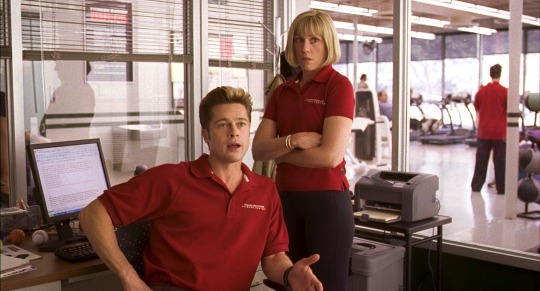
16. Burn After Reading (2008)
This film is what Intolerable Cruelty wanted to be... a property that is a hair closer to by the books, but full of a screwball approach that heralds to a forgotten era of film while using an incredibly stacked cast. Of all the Coen Brothers films I’ve seen, Burn After Reading feels like the property that all involved enjoyed making the most. Like many of the Coen Brothers films, the cast on this one is mega-stacked, and from top to bottom, everyone involved shines in roles that go against their standard types, or amplify the most off-beat aspects of their performing ability.
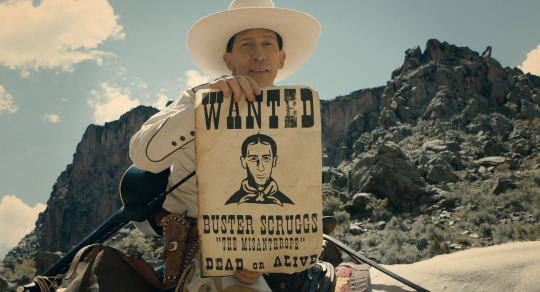
15. The Ballad of Buster Scruggs (2018)
The fact that Netflix was able to pull the Coen Brothers for a film is a win in itself, and with the duo choosing to do an anthology piece, Netflix was primed to maximize on their investment. While highly entertaining, however, the anthology nature of the property leaves it feeling a bit unfocused and disjointed at times... none of these stories really had enough meat on the bone to be expanded into feature-length films of their own, but for some reason, all parties involved passed on the opportunity to make a multi-episode serial rather than a film comprised of multiple tales. While using variance in storytelling methods and visual styles may work for some less talented directors, in the case of The Ballad of Buster Scruggs, it feels more like snack-sized bites in the place of true sustenance.
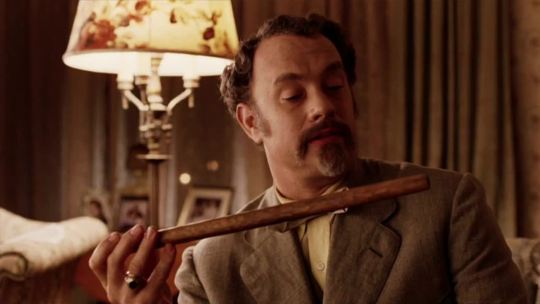
14. The Ladykillers (2004)
On paper, this film should have been a disaster. The Coen Brothers generally opt for original stories, so the fact that they chose to adapt such an obscure 1950s property for the modern day was strange, especially in light of the fact that most every element with the exception of Tom Hanks’ character was given a modern update. Somehow, despite all of this oddness, The Ladykillers managed to capture a sense of the classic Coen Brothers slapstick comedy that they famously established themselves with early on in their career. Tom Hanks is given the green light to go completely ridiculous, and to much of the viewers’ delight, he does so with great aplomb. His supporting cast shines, the comedic turn brings new energy to the story, and the southern gospel setting brings a rich sense of spirituality to an otherwise run of the mill film.

13. O Brother, Where Art Thou? (2000)
The Coen Brothers were essentially household names by the turn of the 20th century, but O Brother, Where Art Thou? propelled them into a legendary status. The grassroots mix of The Odyssey and the Robert Johnson crossroads legend took on a life of its own, leaving behind a soundtrack that birthed an entire generation of folk and bluegrass enthusiasts, as well as a film that showed the world George Clooney’s comedic chops. Much like The Ladykillers, O Brother puts viewers deep into the unfamiliar territory of Southern ‘discomfort’, with the African-American experience playing a major role in the narrative. Of all the Coen Brothers films one could use to introduce a stranger to their catalog, this one may be the best, as its infectious nature and stunning look leaves an impression on most anyone who has the pleasure to view it.
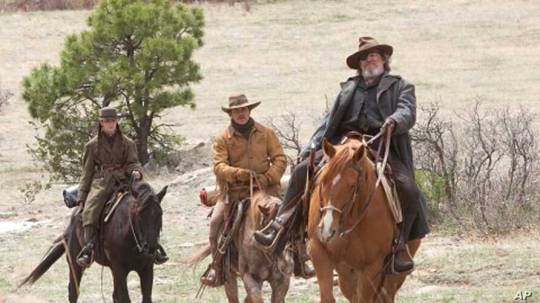
12. True Grit (2010)
The Coen Brothers had already covered a wide bit of genre ground within their first three decades, but surprisingly, they’d not done a true western up to that point (though many argue that No Country For Old Men is a modern take on the western). Therefore, when it was announced that their first western would be a remake of the iconic John Wayne film True Grit, many were surprised, and curious if they could pull it off. Not only did they pull it off, but in my humble opinion, they made a version that more than holds its own against the original. For the handful of big name and seasoned actors that signed on, it was the breakthrough performance of relative newcomer Hailee Steinfeld that outshined all. While The Ballad of Buster Scruggs was a fun revisit to the world of the western, True Grit was the kind of achievement that makes me want more traditional westerns from the duo.
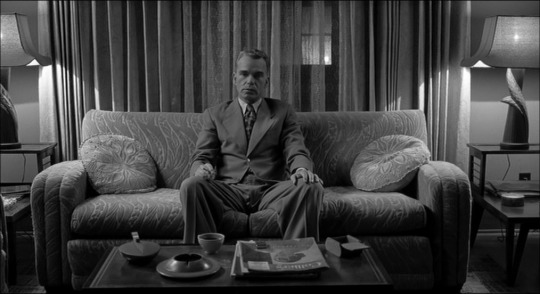
11. The Man Who Wasn’t There (2001)
Listing the Coen Brothers films is by far the most difficult ranking I’ve done to date, and the first film that really gave me trouble in terms of placement was The Man Who Wasn’t There. Personally, I find this film to be captivating and nearly flawless... Billy Bob Thornton’s detachment is rich and intrusive, which makes it all the more sinister when he does choose to exude even a hint of passion about something, be it positive or negative. The black and white photography, in league with the tone of the film, puts me in the mindset of films like In Cold Blood, and some of the sequences in the film stand out as some of the most iconic in the world of Coen Brothers films, especially the car crash. For a classic-style film noir, a genre that anyone with half a brain knew was a slam dunk for the Coens, the duo went above and beyond to both modernize and wholly embody the style. One of several Coen Brothers films that sits with you long after the final credits have faded away.

10. Inside Llewyn Davis (2013)
If this isn’t the darkest comedy in the Coen collection, it’s certainly giving the number one contender a run for its money. The intimacy of this film is unmatched within the broader collection of Coen characters, excluding The Dude, but the difference between Llewyn and The Dude is the personality equivalent of the difference between oil and water. You may marvel at Llewyn’s talent, but all the while, the film is screaming at you that “THIS IS A CHARACTER YOU SHOULD NOT ROOT FOR”. The symbolism found in the film is minimal while being incredibly effective in how it punctuates Llewyn’s personality and character, and the story structure is an equally subtle swerve that baits you into paying deeper attention, only to realize that the setup was the punchline the entire time.

9. The Hudsucker Proxy (1994)
I’m a sucker for a Coen Brothers comedy, especially the ones that play like human cartoons, and one of their absolute best was The Hudsucker Proxy. The writing on this film is so tight that it would absolutely pop if it were any tighter. The entire A Christmas Carol-esque approach to the story makes it a wonderful moralistic tale that makes people laugh so much that they often don’t realize they are being taught a lesson about morals, integrity and self-respect. Tons of familiar character actors fill the frames, everyone tasked with supporting roles fit firmly and comfortably into the created world, and the man trio of Tim Robbins, Jennifer Jason Leigh and Paul Newman are functioning on genius levels of performance... especially Jennifer Jason Leigh. While not quite a holiday movie, there is enough of a holiday sense that it could be shoehorned into a seasonal viewing, but any time set aside for this gem is the right time to watch it.
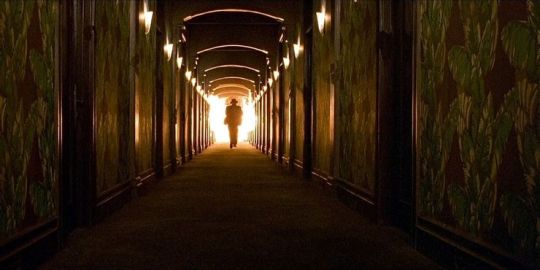
8. Barton Fink (1991)
In my humble opinion, this may be the strongest end to end performance from John Turturro in his long and storied career. As clear-cut fans of film, it is always a pleasure to see the Coen Brothers explore the world of film, and by using this approach, they are able to tell a bold, brash and haunting tale about the issues that come with assumptions about character and talent. The takes on Hollywood and the indifference of those in power, especially when it comes to assisting young and promising talents that may one day usurp them, and powerful. The real bow on the story, however, is the larger than life presence of John Goodman, who goes from being a slightly aggressive and overbearing sense of support to a literal madman by both name and action. For a film that mainly consists of individuals talking to one another about passion, talent and secrets, there is a kinetic energy that feeds the forward momentum of this movie, and for that, it stands out in the Coen collection.
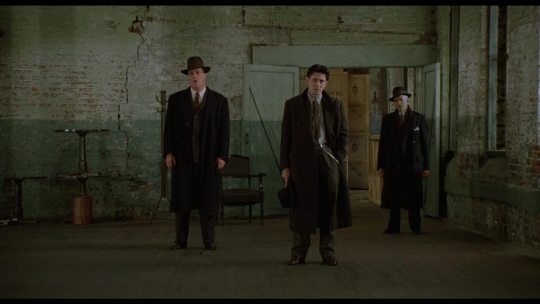
7. Miller’s Crossing (1990)
It’s not surprising that the Coen Brothers could make a compelling and memorable gangster film, but I don’t think that anyone expected a film as vicious and dark as Miller’s Crossing. For a duo that generally relies on nuance and contemplation to get their points across, this film certainly proves that they are more than capable of excelling in the direct approach as well. The era-specific costuming is outstanding, the murky city areas stand in stark contrast to the woods of the titular Miller’s Crossing, and the sheer volume of bullets are a stark reminder of the Prohibition-era story we are viewing. Gabriel Byrne shines in his lead role, bringing a world of fury, deceit and mistrust in tow with him. The iconic hat blowing in the wind serves as not only the biggest memorable moment from the film, but possibly also the single moment of peace and beauty found in a film that holds up a dirty mirror to a dark world.
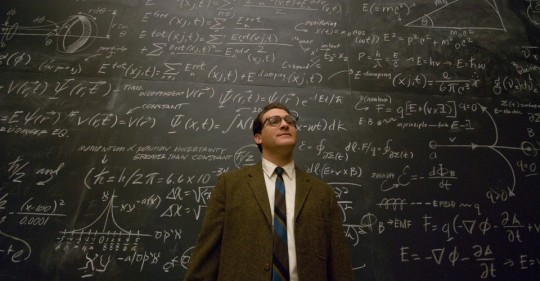
6. A Serious Man (2009)
Of all Coen Brothers films, this is easily the most underappreciated and slept on of the bunch. I’m a sucker for movies that embrace Murphy’s Law, and when mixed with the parable nature of the Book of Job, we are presented with a darkly comic and relatively unique version of the hero’s journey. The way that the personal, professional and philosophical problems pile up on Michael Stuhlbarg’s Larry are meant to be felt by the audience, and the way that his bad luck boomerangs out into the world during the film’s resolution must be seen in order to be believed. The way that destiny and chance dance around one another in this film is narratively breathtaking, and for such a subtle film, it is a truly remarkable achievement.

5. No Country For Old Men (2007)
When you think of the Coen Brothers, you don’t necessarily think of evil incarnate, and yet, the duo succeeded in capturing a character in the form of Anton Chigurh, the closest thing to the Terminator that the duo has ever created (to my knowledge). The story is a wonderful, subtle tale of how the times can change into something we don’t recognize before we recognize the change, but it is easily Javier Bardem’s iconic performance that gives this film all of its power and ominous energy. His unyielding forward momentum, his disdain for obstacles in any form, and his disregard for human life are enough to instill real fear into those who partake in viewings, and his presence will more than likely haunt you far beyond completion of the film. A true modern-day masterpiece that would have been higher, if not for...

4. Blood Simple (1984)
What a powerful debut, and one that not only hinted at, but outright put the spotlight on the promise of the Coen Brothers when it came to stark visuals and stunning storytelling. For such a simple, small scale story, the tangled web that is woven is a slippery slope of deception and distrust that leaves little to no survivors in its wake. The scale of the film is deceptively small, but the quality shines in every aspect that it can. Seeds are placed that pay off wonderfully, and the color palette presented gives the film the feeling of a Technicolor film-noir. Much like A Serious Man, Blood Simple deserves to be talked about and held up much more than it is by fans of film.
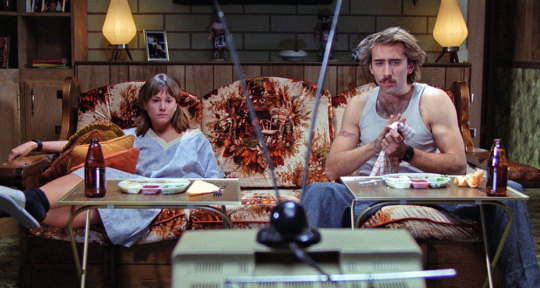
3. Raising Arizona (1987)
What a wonderfully ridiculous movie about something as simple as the trials and tribulations of navigating love, marriage and parenthood. The most hilarious aspect of this film, in my opinion, is how it feels like a living and breathing cartoon, both in terms of the character performances and the outrageous events that take place within the world of the film. Nicolas Cage is operating on a completely different level, Holly Hunter is equal parts charming and hilarious, Trey Wilson is wonderfully over the top, John Goodman and William Forsythe bring excess hilarity to the wild proceedings, and Randall “Tex” Cobb is downright iconic in terms of his ridiculous character. The pacing of the film is breakneck and feverish, the comedy hits never stop coming, and the utter charm emanating from the midst of the caper presented is infectious. As a second film, this could not be any more different than Blood Simple, and yet somehow, it connected so vividly with viewers that it remains a must-watch film to this day.

2. Fargo (1996)
What is there to be said about Fargo that has not already been said? For a duo with more iconic films to their name than some directors have completed films, Fargo was an immediate signal that the limits of the Coen Brothers’ creativity and skill had not even began to show its full breadth. Within less than five years of release, the film was already heralded as a classic (of all-time, not just modern day), the mystery surrounding its possibility of being based on a true story built a world of intrigue around the movie, and it has gone on to create a universe of its own in the form of an FX TV show that recently wrapped its fourth season. There is not a wasted role in this film, and to this day, any movie fan worth their salt will happily bust out their version of a Minnesota accent that is almost certainly based on one of the many memorable characters that inhabit the world of Fargo. Numerous actors, including William H. Macy, Frances McDormand and Steve Buscemi, all found breakout success in the wake of this wonderful film.

1. The Big Lebowski (1998)
Was there ever any doubt for this placement? For everything that Fargo did in terms of success within the world of the film industry, The Big Lebowski did that and more for the worlds of the counter-culture and cult film fans. The story we are presented with is so simple, yet so ridiculous in its journey, that it almost insists on viewers revisiting it over and over. Like many Coen Brothers films, nobody cast in the film is wasted or misused, and due to these stellar performances, the film finds itself as one of the most quotable in recent memory. Much like the performances of the cast, the writing does not waste any words or opportunities, often referring back to itself in extremely subtle and nuanced ways that present themselves over time, and to hilarious effect. Nobody would have expected a film of this nature to have a fandom, and yet, the legions of fans for this film are unique to that of the Coen Brothers catalog in the sense of their dedication, devotion to and love of the movie. While not everyone’s cup of tea upon first viewing, The Big Lebowski is truly an example of the gift that keeps on giving.
If the Coen Brothers never make another film, they’ve already created and achieved more in their journey that most filmmakers can dream of. Many of their films could honestly be considered works of art, and nearly all of them are compelling with an ability to leave deep and lasting impressions. If you are unfamiliar with the Coen Brothers, do yourself a favor and check out their work, as it may bring a new sense of invigoration to your love of film.
Editor’s Note (12/10/2020) : Inside Llewyn Davis added to the number 10 position, all films ranked lower adjusted accordingly.
#ChiefDoomsday#DOOMonFILM#JoelCoen#EthanCoen#CoenBrothers#BloodSimple#RaisingArizona#MillersCrossing#BartonFink#TheHudsuckerProxy#Fargo#TheBigLebowski#OBrotherWhereArtThou#TheManWhoWasntThere#IntolerableCruelty#TheLadykillers#NoCountryForOldMen#BurnAfterReading#ASeriousMan#TrueGrit#InsideLlewynDavis#HailCaesar#TheBalladOfBusterScruggs
4 notes
·
View notes
Text
Alice Bolin, The Ethical Dilemma of Highbrow True Crime, Vulture (August 1, 2018)
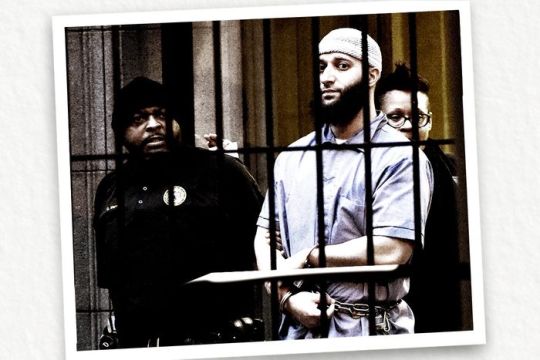
The “true-crime boom” of the mid- to late 2010s is a strange pop-culture phenomenon, given that it is not so much a new type of programming as an acknowledgement of a centuries-long obsession: People love true stories about murder and other brands of brutality and grift, and they have gorged on them particularly since the beginning of modern journalism. The serial fiction of Charles Dickens and Wilkie Collins was influenced by the British public’s obsessive tracking of sensational true-crime cases in daily papers, and since then, we have hoarded gory details in tabloids and pulp paperbacks and nightly news shows and Wikipedia articles and Reddit threads.
I don’t deny these stories have proliferated in the past five years. Since the secret is out — “Oh you love murder? Me too!” — entire TV networks, podcast genres, and countless limited-run docuseries have arisen to satisfy this rumbling hunger. It is tempting to call this true-crime boom new because of the prestige sheen of many of its artifacts — Serial and Dirty John and The Jinx and Wild, Wild Country are all conspicuously well made, with lovely visuals and strong reporting. They have subtle senses of theme and character, and they often feel professional, pensive, quiet — so far from vulgar or sensational.
But well-told stories about crime are not really new, and neither is their popularity. In Cold Blood is a classic of American literature and The Executioner’s Song won the Pulitzer; Errol Morris has used crime again and again in his documentaries to probe ideas like fame, desire, corruption, and justice. The new true-crime boom is more simply a matter of volume and shamelessness: the wide array of crime stories we can now openly indulge in, with conventions of the true-crime genre more emphatically repeated and codified, more creatively expanded and trespassed against. In 2016, after two critically acclaimed series about the O.J. Simpson trial, there was talk that the 1996 murder of Colorado 6-year-old JonBenét Ramsey would be the next case to get the same treatment. It was odd, hearing O.J.: Made in America, the epic and depressing account of race and celebrity that won the Academy Award for Best Documentary, discussed in the same breath with the half-dozen unnecessary TV specials dredging up the Ramsey case. Despite my avowed love of Dateline, I would not have watched these JonBenét specials had a magazine not paid me to, and suffice it to say they did very little either to solve the 20-year-old crime (ha!) or examine our collective obsession with it.
Clearly, the insight, production values, or cultural capital of its shiniest products are not what drives this new wave of crime stories. O.J.: Made in America happened to be great and the JonBenét specials happened to be terrible, but producers saw them as part of the same trend because they knew they would appeal to at least part of the same audience. I’ve been thinking a lot about these gaps between high and low, since there are people who consume all murder content indiscriminately, and another subset who only allow themselves to enjoy the “smart” kind. The difference between highbrow and lowbrow in the new true crime is often purely aesthetic. It is easier than ever for producers to create stories that look good and seem serious, especially because there are templates now for a style and voice that make horrifying stories go down easy and leave the viewer wanting more. But for these so-called prestige true-crime offerings, the question of ethics — of the potential to interfere in real criminal cases and real people’s lives — is even more important, precisely because they are taken seriously.
Like the sensational tone, disturbing, clinical detail, and authoritarian subtext that have long defined schlocky true crime as “trash,” the prestige true-crime subgenre has developed its own shorthand, a language to tell its audience they’re consuming something thoughtful, college-educated, public-radio influenced. In addition to slick and creative production, highbrow true crime focuses on character sketches instead of police procedure. “We’re public radio producers who are curious about why people do what they do,” Phoebe Judge, the host of the podcast Criminal, said. Judge has interviewed criminals (a bank robber, a marijuana brownie dealer), victims, and investigators, using crime as a very simple window into some of the most interesting and complicated lives on the planet.
Highbrow true crime is often explicitly about the piece’s creator, a meta-commentary about the process of researching and reporting such consequential stories. Serial’s Sarah Koenig and The Jinx’s Andrew Jarecki wrestle with their boundaries with the subjects (Adnan Syed and Robert Durst, respectively, both of whom have been tried for murder) and whether they believe them. They sift through evidence and reconstruct timelines as they try to create a coherent narrative from fragments.
I remember saying years ago that people who liked Serial should try watching Dateline, and my friend joked in reply, “Yeah, but Dateline isn’t hosted by my friend Sarah.” One reason for the first season of Serial’s insane success — it is still the most-downloaded podcast of all time — is the intimacy audiences felt with Koenig as she documented her investigation of a Baltimore teenager’s murder in real time, keeping us up to date on every vagary of evidence, every interview, every experiment. Like the figure of the detective in many mystery novels, the reporter stands in for the audience, mirroring and orchestrating our shifts in perspective, our cynicism and credulity, our theories, prejudices, frustrations, and breakthroughs.
This is what makes this style of true crime addictive, which is the adjective its makers most crave. The stance of the voyeur, the dispassionate observer, is thrilling without being emotionally taxing for the viewer, who watches from a safe remove. (This fact is subtly skewered in Gay Talese’s creepy 2017 Netflix documentary, Voyeur.) I’m not sure how much of my eye-rolling at the popularity of highbrow true crime has to do with my general distrust of prestige TV and Oscar-bait movies, which are usually designed to be enjoyed in the exact same way and for the exact same reasons as any other entertainment, but also to make the viewer feel good about themselves for watching. When I wrote earlier that there are viewers who consume all true crime, and those who only consume “smart” true crime, I thought, “And there must be some people who only like dumb true crime.” Then I realized that I am sort of one of them.
There are specimens of highbrow true crime that I love, Criminal and O.J.: Made in America among them, but I truly enjoy Dateline much more than I do Serial, which in my mind is tedious to the edge of pointlessness. I find myself perversely complaining that good true crime is no fun — as self-conscious as it may be, it will never be as entertaining as the Investigation Discovery network’s output, most of which is painfully serious. (The list of ID shows is one of the most amusing artifacts on the internet, including shows called Bride Killas, Momsters: Moms Who Murder, and Sex Sent Me to the Slammer.) Susan Sontag famously defined camp as “seriousness that fails,” and camp is obviously part of the appeal of a show called Sinister Ministers or Southern Fried Homicide. Network news magazine shows like Dateline and 48 Hours are somber and melodramatic, often literally starting voice-overs on their true-crime episodes with variations of “it was a dark and stormy night.” They trade in archetypes — the perfect father, the sweet girl with big dreams, the divorcee looking for a second chance — and stick to a predetermined narrative of the case they’re focusing on, unconcerned about accusations of bias. They are sentimental and yet utterly graphic, clinical in their depiction of brutal crimes.
It’s always talked around in discussions of why people like true crime: It is … funny? The comedy in horror movies seems like a given, but it is hardly permitted to say that you are amused by true disturbing stories, out of respect for victims. But in reducing victims and their families to stock characters, in exaggerating murderers to superhuman monsters, in valorizing police and forensic scientists as heroic Everymen, there is dark humor in how cheesy and misguided these pulpy shows are, how bad we are at talking about crime and drawing conclusions from it, how many ways we find to distance ourselves from the pain of victims and survivors, even when we think we are honoring them. (The jokey titles and tongue-in-cheek tone of some ID shows seem to indicate more awareness of the inherent humor, but in general, the channel’s programming is almost all derivative of network TV specials.) I’m not saying I’m proud of it, but in its obvious failures, I enjoy this brand of true crime more straightforwardly than its voyeuristic, documentary counterpart, which, in its dignified guise, has maybe only perfected a method of making us feel less gross about consuming real people’s pain for fun.
Crime stories also might be less risky when they are more stilted, more clinical. To be blunt, what makes a crime story less satisfying are often the ethical guidelines that help reporters avoid ruining people’s lives. With the popularity of the podcasts S-Town and Missing Richard Simmons, there were conversations about the ethics of appropriating another person’s story, particularly when they won’t (or can’t) participate in your version of it. The questions of ethics and appropriation are even heavier when stories intersect with their subjects’ criminal cases, because journalism has always had a reciprocal relationship with the justice system. Part of the exhilarating intimacy of the first season of Serial was Koenig’s speculation about people who never agreed to be part of the show, the theories and rabbit holes she went through, the risks she took to get answers. But there is a reason most reporters do all their research, then write their story. It is inappropriate, and potentially libelous, to let your readers in on every unverified theory about your subject that occurs to you, particularly when wondering about a private citizen’s innocence or guilt in a horrific crime.
Koenig’s off-the-cuff tone had other consequences, too, in the form of amateur sleuths on Reddit who tracked down people involved with the case, pored over court transcripts, and reviewed cellular tower evidence, forming a shadow army of investigators taking up what they saw as the gauntlet thrown down by the show. The journalist often takes on the stance of the professional amateur, a citizen providing information in the public interest and using the resources at hand to get answers. At times during the first season of Serial, Koenig’s methods are laughably amateurish, like when she drives from the victim’s high school to the scene of the crime, a Best Buy, to see if it was possible to do it in the stated timeline. She is able to do it, which means very little, since the crime occurred 15 years earlier. Because so many of her investigative tools were also ones available to listeners at home, some took that as an invitation to play along.
This blurred line between professional and amateur, reporter and private investigator, has plagued journalists since the dawn of modern crime reporting. In 1897, amid a frenzied rivalry between newspaper barons William Randolph Hearst and Joseph Pulitzer, true crime coverage was so popular that Hearst formed a group of reporters to investigate criminal cases called the “Murder Squad.” They wore badges and carried guns, forming essentially an extralegal police force who both assisted and muddled official investigations. Seeking to get a better story and sell more papers, it was common for reporters to trample crime scenes, plant evidence, and produce dubious witnesses whose accounts fit their preferred version of the case. And they were trying to get audiences hooked in very similar ways, by crowdsourcing information and encouraging readers to send in tips.
Of course the producers of Serial never did anything so questionable as the Murder Squad, though there are interesting parallels between the true-crime podcast and crime coverage in early daily newspapers. They were both innovations in the ways information was delivered to the public that sparked unexpectedly personal, participatory, and impassioned responses from their audiences. It’s tempting to say that we’ve come full circle, with a new true-crime boom that is victim to some of the same ethical pitfalls of the first one: Is crime journalism another industry deregulated by the anarchy of the internet? But as Michelle Dean wrote of Serial, “This is exactly the problem with doing journalism at all … You might think you are doing a simple crime podcast … and then you become a sensation, as Serial has, and the story falls to the mercy of the thousands, even millions, of bored and curious people on the internet.”
Simply by merit of their popularity, highbrow crime stories are often riskier than their lowbrow counterparts. Kathryn Schulz wrote in The New Yorker about the ways the makers of the Netflix series Making a Murderer, in their attempt to advocate for the convicted murderer Steven Avery, omit evidence that incriminates him and put forth an incoherent argument for his innocence. Advocacy and intervention are complicated actions for journalists to undertake, though they are not novel. Schulz points to a scene in Making a Murderer where a Dateline producer who is covering Avery is shown saying, “Right now murder is hot.” In this moment the creators of Making a Murderer are drawing a distinction between themselves and Dateline, as Schulz writes, implying that, “unlike traditional true-crime shows … their work is too intellectually serious to be thoughtless, too morally worthy to be cruel.” But they were not only trying to invalidate Avery’s conviction; they (like Dateline, but more effectively) were also creating an addictive product, a compelling story.
That is maybe what irks me the most about true crime with highbrow pretensions. It appeals to the same vices as traditional true crime, and often trades in the same melodrama and selective storytelling, but its consequences can be more extreme. Adnan Syed was granted a new trial after Serial brought attention to his case; Avery was denied his appeal, but people involved in his case have nevertheless been doxxed and threatened. I’ve come to believe that addictiveness and advocacy are rarely compatible. If they were, why would the creators of Making a Murderer have advocated for one white man, when the story of being victimized by a corrupt police force is common to so many people across the U.S., particularly people of color?
It does feel like a shame that so many resources are going to create slick, smart true crime that asks the wrong questions, focusing our energy on individual stories instead of the systemic problems they represent. But in truth, this is is probably a feature, not a bug. I suspect the new true-crime obsession has something to do with the massive, terrifying problems we face as a society: government corruption, mass violence, corporate greed, income inequality, police brutality, environmental degradation, human-rights violations. These are large-scale crimes whose resolutions, though not mysterious, are also not forthcoming. Focusing on one case, bearing down on its minutia and discovering who is to blame, serves as both an escape and a means of feeling in control, giving us an arena where justice is possible.
Skepticism about whether journalists appropriate their subjects’ stories, about high and low, and about why we enjoy the crime stories we do, all swirl through what I think of as the post–true-crime moment. Post–true crime is explicitly or implicity about the popularity of the new true-crime wave, questioning its place in our culture, and resisting or responding to its conventions. One interesting document of post–true crime is My Favorite Murder and other “comedy murder podcasts,” which, in retelling stories murder buffs have heard on one million Investigation Discovery shows, unpack the ham-fisted clichés of the true-crime genre. They show how these stories appeal to the most gruesome sides of our personalities and address the obvious but unspoken fact that true crime is entertainment, and often the kind that is as mindless as a sitcom. Even more cutting is the Netflix parody American Vandal, which both codifies and spoofs the conventions of the new highbrow true crime, roasting the genre’s earnest tone in its depiction of a Serial-like investigation of some lewd graffiti.
There is also the trend in the post–true-crime era of dramatizing famous crime stories, like in The Bling Ring; I, Tonya; and Ryan Murphy’s anthology series American Crime Story, all of which dwell not only on the stories of infamous crimes but also why they captured the public imagination. There is a camp element in these retellings, particularly when famous actors like John Travolta and Sarah Paulson are hamming it up in ridiculous wigs. But this self-consciousness often works to these projects’ advantage, allowing them to show heightened versions of the cultural moments that led to the most outsize tabloid crime stories. Many of these fictionalized versions take journalistic accounts as their source material, like Nancy Jo Sales’s reporting in Vanity Fair for The Bling Ring and ESPN’s documentary on Tonya Harding, The Price of Gold, for I, Tonya. This seems like a best-case scenario for prestige true crime to me: parsing famous cases from multiple angles and in multiple genres, trying to understand them both on the level of individual choices and cultural forces.
Perhaps the most significant contributions to post–true crime, though, are the recent wave of personal accounts about murder and crime: literary memoirs like Down City by Leah Carroll, Mean by Myriam Gurba, The Hot One by Carolyn Murnick, After the Eclipse by Sarah Perry, and We Are All Shipwrecks by Kelly Grey Carlisle all tell the stories of murder seen from close-up. (It is significant that all of these books are by women. Carroll, Perry, and Carlisle all write about their mothers’ murders, placing them in the tradition of James Ellroy’s great memoir My Dark Places, but without the tortured, fetish-y tone.) This is not a voyeuristic first person, and the reader can’t detach and find joy in procedure; we are finally confronted with the truth of lives upended by violence and grief. There’s also Ear Hustle, the brilliant podcast produced by the inmates of San Quentin State Prison. The makers of Ear Hustle sometimes contemplate the bad luck and bad decisions that led them to be incarcerated, but more often they discuss the concerns of daily life in prison, like food, sex, and how to make mascara from an inky page from a magazine. This is a crime podcast that is the opposite of sensational, addressing the systemic truth of crime and the justice system, in stories that are mundane, profound, and, yes, addictive.
#true crime#adnan syed#media#ethics#The Way We Live Now#culture#andrew jarecki#james ellroy#criminal justice#detective fiction
3 notes
·
View notes
Text
the first avatar sequel was a huge success - more so, indeed, than the original. people loved it, and james cameron fast-tracked the next several sequels. soon the avatar franchise dominates the movie industry, much like the MCU did in the 2010s - people were extremely invested in the characters; the story was engaging; the franchise made billions of billions of dollars for disney for the remainder of james cameron’s life.
but james cameron could not live forever, and on january 30th, 2038, he passed away at age 83 from organ failure, leaving behind a cinematic franchise for the ages.
and for the ages it was, for now that the intellectual property was free from his creative vision, the studio distorted his vision and continued to make sequel after spinoff after sidequest. soon it seemed as though every movie was a new avatar - and in time it was. 2079 was the first year in which every film to earn over one million at the box office was an avatar film; other films, while present, struggled to scrape together the budget or interest to keep going, and gradually other studios closed their doors. after all, who cares about exploring the fragile nature of the human spirit when one could instead see a blue person run from an explosion?
now with the avatar franchise dominating popular culture, the flaws begin to show through even more obviously. the movies had always had their detractors, of course, but now the studio was nearly free of competition. the company stagnated, and the once-beautiful films turned into repetitive slogs of explosions, poor colour grading, and bad quips that replace genuine emotion. often entire sequences are blatantly reused, and indeed the 2095′s A.V.TAR - the one hundredth in the main series - was little more than a clip show recapping some of the more memorable moments from the series’s history. but what could we do? no other form of entertainment was profitable anymore.
and so the blue march continued onwards into the new century. the avatar corporation celebrated 2100 by announcing plans to acquire and terraform Io, creating “pandora-land” where the obscenely wealthy could visit a planet-wide theme park for a handsome price. and people paid through the nose for it - paid through the nose for a long space voyage, for poorly-maintained facilities, for subpar rollercoasters
by the dawning of the 2140s, over seven billion people had visited the park. none could truly say they had derived any joy from the experience, but it was avatar - they loved it. they knew they loved it. avatar was safe, comforting. avatar was always there. avatar had always been there. avatar would be there always in the future. little did they know what was about to transpire.
46 notes
·
View notes
Text
Ghost Are Shaping To Be Metal’s Next Awe-Inspiring Arena Act
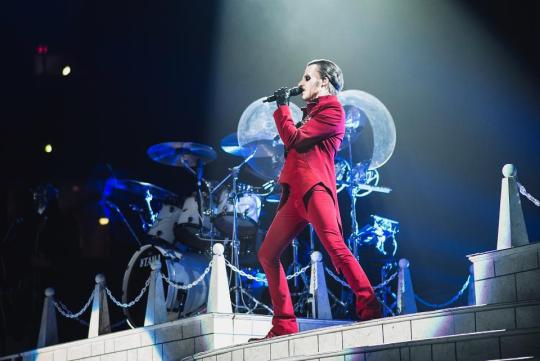
From Motorhead, to Black Sabbath, and now the thrash kings, Slayer, metal is slowly losing its festival headliners, arena fillers, and most importantly its legacy acts. While it’s been a rather gradual shift, time only moves forward, and sooner or later metal will have to knight a new generation of arena and festival heavy weights. Early 2000’s bands like Slipknot, Avenged Sevenfold, and Disturbed have long demonstrated a knack for selling out arenas and filling headlining slots at festivals. However, most of these bands have rocked for nearly two decades, and it’s time for the 2010’s to showcase its respective arena acts. Currently completing their first US arena tour, Ghost are leading the charge for the next wave of arena and festival headliners.
Established in 2010 with their debut, Opus Eponymous, Ghost is quite possibly the fastest growing and most popular metal band of the decade. At first glance, the Swedish metal group embodies a very satanic aura, from their upside down crosses and the litany of demonic and catholic symbolism. While the music is the primary focus, their costumes and theatrics as a band are essential to the image and mythos they’ve established over the course of their career. They’ve even gone as far as making a web-series on their youtube channel, detailing the fictitious origins of the band and it’s current vocalist in power, Cardinal Copia. All masks and costumes aside, Tobias Forge is the creative force behind Ghost, being the band’s songwriter, lead vocalist, and founder. Tobias is actually the only known member, all the touring instrumentalists are incognito and share the stage name “Nameless Ghoul.”
As scary and sinister looking as they might be, Ghost brings one of the most melodic, catchy, and entertaining live shows in all of modern metal. Seeing them at their Hersey, PA stop was a remarkable and genuine concert experience; the crowd participation and the sheer enthusiasm that packed Giant Center arena is unrivaled by any band I’ve seen from the 2010’s. The crowd’s enthusiastic chemistry is comparative to Ghost’s onstage chemistry, with their goofy choreographed antics, and just their flawless musicianship between one another. Ghost’s stage production alone was worth an entry ticket; the cathedral-like stage spewed everything from pyro, fireworks, to a confetti filled finale. There’s something very authentic about Ghost as a band, but also as performers. They cater to several aspects of metal and rock music, but also theater in many ways, and at the end of the day Ghost is just pure entertainment, they give something for everyone to enjoy, and leave you feeling just awestruck.
Getting the chance to speak with Tobias Forge, he details the evolution of Ghost and how they got to their arena headlining status over the years.
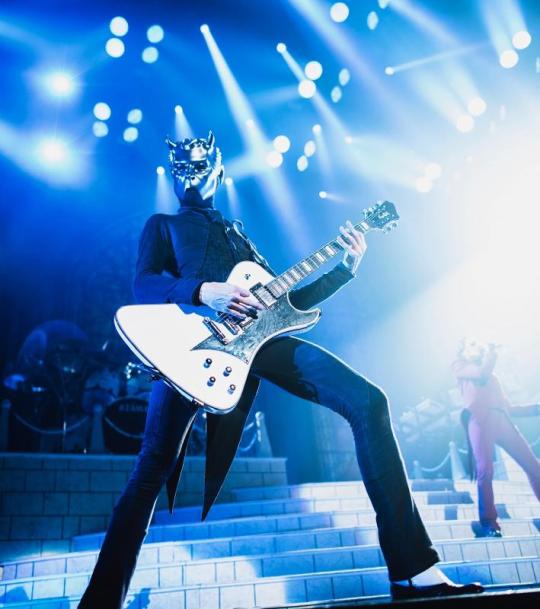
Ghost went from opening arenas for Avenged Sevenfold in 2013, to more recently opening soccer stadiums for Metallica this summer, to now headlining your own arenas in the states, and soon to be in Europe. What’s the transition been like from opening arenas to now headlining them?
It’s been pretty gradual, over the years we’ve done support shows here and there, support tours here and there, but by the time that we headlined our first arena, which was now a few years ago, we had done quite a lot of arena shows before that, opening up. It wasn’t like a big physical shock, most bands will probably tell you that the weirdest thing about playing bigger places is usually you have to cover so much space on stage, like physically you have to. If you’re a semi-active rock band, the biggest shock from going to a club to arena or even worse, a stadium, is that all of a sudden you have so much physical ground, so much real estate to cover, which can be a shock. If you’re not used to running, and you have to run from one side to the other, and sing, that will punch you out. Gradually we’ve moved up through these venues, and on the first bit of the tour, not this tour leg, but on the tour when it started, we were doing “an evening with,” which meant we were playing two hours and forty minutes, and I definitely had a little bit of a shock over the first night like “whoa,” it was very tiring.
From an Economics, marketing, and profit standpoint, how have these aspects changed or evolved with “the ultimate tour named death?”
It’s kind of like what you’d say about bringing children up, if you have small children the problems are sort of small, and if you have older children then they are bigger. So you know back a few years when we were a band and crew in one bus, it took some time before we even had a truck. Now we’re three buses of people and six trucks, and it’s sort of the bigger the show the more it costs. That is the dynamic of every tour in the world, and the only thing that is making it harder for a band like ours is that it’s sort of new in the greater scheme of things, and in comparison to a lot of the other bands that are doing it on this level, or on an even bigger level. We are a new band that has managed to qualify into this setting, and if you look at most other very established and older artists, they charge a lot more for their tickets, a lot more than we do. That’s sort of the law of gravity and that makes it sometimes a little bit uphill, but we are fortunate to have the promoters and festivals believing in us on a worldwide basis. They believe in the idea that they need to invest in new headliners, the stars have aligned and fortunately they believe us to be one of the new ones to be able to fill that space. Just back a few years, there were several bands out there, but you know Black Sabbath is gone, and so many bands are just retiring or dying and in order to sustain these festivals they will need to invest in new bands and we’re one of them. However, you can clearly see on a festival of three days where The Scorpions are headlining one night, Kiss is headlining another night, and we are headlining a third, we are not getting paid the same as they are, of course not. The bottom line with that is we’re still looked upon and it’s expected of Ghost to deliver the same show, and that requires determination and you cannot look for economic return at this point. It’s further down the line of years and years and years of proving yourself, but that’s part of the game and that’s what I’ve been doing for almost ten years now.
You’ve stated the excitement for this tour was not only the fact Ghost would be playing arenas, but because the tour is spread across so many different markets. How has the reception been so far, in playing to these different markets, or territories that Ghost has less experience performing in?
The reception at the shows has been fantastic. Of course there are a few markets where it’s hard to expect anything because it’s in the middle of no where, and on top of that some of these shows have been on Mondays, Tuesdays, Wednesdays, and you can clearly see the ones that are on the weekends are doing way better. A lot these places that we’re playing are essentially in small towns, so they will have a magnetism for towns and cities around them, so people have to travel to come see it. That’s sort of the basis of that market in the first place, of course it’s a little bit sensitive if it’s a Monday or a Friday, but I must say that overall the promoter is very pleased, and we’re living up to the expectation of what a tour like this can do. That’s the point of the tour, reach out to people in territories where we haven’t really been, and having that in mind it’s been fantastic.
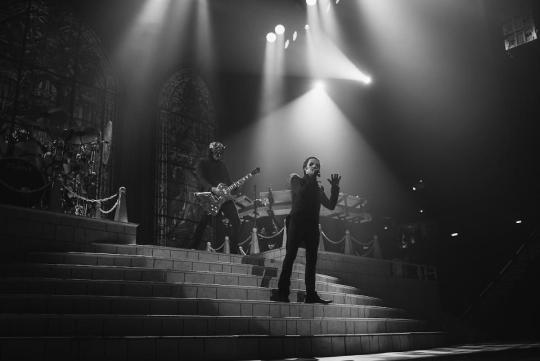
Have you held the idea or goal of Ghost inhabiting stadiums, or large venues since you started the band? These environments seem embedded in the very nature of Ghost’s live show.
My answer will be a little bit split between yes and no. Yes, I have always intended for my band to become a big arena headlining production value band. I always thought that Ghost as a project would be very production oriented. I never thought that Ghost would be that band, as in when I started I didn’t think that that was going to be the band that would define my entire career. However, once the first record got out and we started playing and we started touring, I had definitely put all my eggs in that basket, because I was like “this is the one that sticks, let’s just do this.” This is the one that I intuitively feel most myself, and I was gravitating towards that. Compared to all my other projects, this is the only one that I really truly understood, and could just do intuitively. I knew what to do with it, where as the other bands that I had were more of a head scratch. A lot of the ideas that I managed to either do or are still on the list with Ghost are things that are based on drawings and ideas that I had fifteen to twenty-five years ago. It’s a mixture, yes and no, I always thought I was going to work either with a band or in a band that was going to do full production touring, but I wasn’t sure it was going to be Ghost. It just happens to be two of my main interests, being in a band and writing songs, but also I’m very interesting in touring, and I’m very interested in the idea of stage design, tour design, light design, and all that. Had it not been for me being in a band, I would have gladly also done it for another band, building stage design for other bands.
Seven Inches of Satanic Panic undoubtedly has a very 60’s rock aesthetic, but specifically what bands from that era are influences to you personally?
Ever since I was a kid my absolute biggest idols before I found extreme metal were from the sixties. It was Pink Floyd, The Doors, The Rolling Stones, The Beatles, I grew up listening to that. When I was eight, my favorite band of all time was The Rolling Stones. I knew everything about them, that was my biggest obsession. The sixties in general and as music have been hugely influential for me. Ghost just happened to be a little bit more heavy metal leaning, but there’s a lot of Pink Floyd in there, and a lot of The Doors, that was the stuff I listened to when I started playing guitar. When I was in my various different bands I’ve always heard that my writing was kind of odd because I had time signatures that were strange, and a melody language that was kind of peculiar. That was because I listened to Pink Floyd and The Doors, they taught me how to just write weirdly, and it’s not as outlandish as it might seem.
Many hail Ghost for their ability to balance a sense of nostalgia whilst maintaining an original song craft and sonic perspective. What has been your process, if not organically, in achieving this balance?
I always try to remember how I felt writing the first record [Opus Eponymous], and during the recording of the record coming after that, [Infestissumam], I think I’ve managed to tap into that. Don’t misunderstand and think I try to write the same record every time, it’s quite the contrary, but having that same playful approach when it came to writing that I had back when I had nothing to lose. Opus Eponymous was written in a complete void, where there was no one involved in my writing. I was depending economically on it, I had no crowd to please, and I had no one to please with my writing except my self and a buddy of mine basically. That’s what I’m trying to do every time; try the best of my ability to stay within that, and not think too much about the fact that “this is your most important record of your career.” With that being said you have that in the back of your mind every time, but you try to even that out, and you try to be somewhat distant from that. I wanted Ghost to sound like a big band, and because I’m trying to distance myself from that, that does not mean the songs aren’t commercial or whatever. I really tried to be commercial on Opus Eponymous, it was supposed to be very very catchy. I wanted it to sound like that huge band that you had missed out on. It was supposed to be very catchy, very memorable, and very playful. It was supposed to be a band from the seventies that didn’t know what the eighties were, but was trying to shape the eighties because they knew that was coming, but they didn’t know what the eighties were.
FORBES.COM
60 notes
·
View notes
Text
A list for @vann-haal of some romance/love-stories! These are just a few that I know well/personally own, so it isn’t the most complete list ever (and I’m sure you’ve seen most of them). I’ll put them under a cut with a small explanation for each. Hope you find at least a couple new ones you like~
Animated-
the Sea Prince and the Fire Child (1981)- this one is fairly obscure, but I somehow managed to get it on video when I was young, and it is a favorite of mine. It is a fantasy story, somewhat similar to Romeo and Juliet with a dash of the Little Mermaid, and a whole new vibe of its own. A child of the sea falls in love with a child of fire, the two only able to meet at night, and always in danger of being caught as their two peoples don’t get along. Very bitter-sweet, and sad at times, but also cute
Shrek (2001)- we all remember this one for totally twisting the fairytale trope “love made her beautiful”, but we still got a happily ever after~
the Book of Life (2014)- I adore the animation and character design, and I find the love story so amusing because if other people didn’t keep messing things up, the two romantic interests would very smoothly be able be able to fall in love without conflict... but, y’know, stuff happens
Gnomeo and Juliet (2011)- I think this one got ignored for having such a silly title and being using a well-known plot, but it is genuinely adorable and funny, knows exactly how silly it is and owns it. We also get to see the two legit fall in love, and try to stay in love
Sailor Moon Promise of the Rose (1993)- pretty much any Sailor Moon movie has a love theme, but this one is my favorite. We see how much Sailor Moon means to all her friends, plus I am just forever entertained that you could describe the plot as “Guy doesn’t know his childhood friend had a scrush on him, childhood friend comes back to steal guy from current girlfriend”
Doug’s 1stMovie (1999)- because the show always featured Doug’s crush on Patti, that becomes a core issue of the plot. He keeps trying to impress her when he should be more worried about other problems, and his selfish behavior accidentally drives her away. Once he calms down and acts honestly, it becomes obvious she cares for him, too
the Prince of Egypt (1998)- the romance is just one aspect of this amazing movies, but it feels real
the Princess and the Frog (2009)- I’m a sucker for both “They don’t get along at first” and “They both help each other find what they need” tropes~
the Swan Princess (1994)- how utterly clueless the main guy is almost frustrating, but he finally comes through at the end, and expresses his feelings in really touching words
Anastasia (1997)- this has a slow-burn going on, plus an “I love you but can’t tell you” element, and the interactions between the romantic leads are always entertaining
Quest for Camelot (1998)- the girl is both very determined and also a disaster, the guy is trying very hard to be the strong siltent type, but she won’t stop talking to him so it isn’t working, and they both just keep saving each other
Beauty and the Beast (1991)- I think we all know this one pretty well, but it is one of my favorites. I just love that from the get-go Belle doesn’t take any nonsense from the Beast, and once he learns to chill, he’s an adorable dork for her
Aladdin (1992)- another well known movie, but also one I love. The Wish definitely didn’t need to be so complicated, but it was, and a comedy of errors ensues. The actual love story is so simple and sweet, even in the middle of all the shenanigans
Megamind (2010)- you know exactly why this is here~
Live Action-
the Princess Bride (1987)- a love story where the two romantic interests only get to spend very little time together, and they are probably even more frustrated about that than we are
Hairspray (2007)- a few different love stories going on, all unique and cute in their own ways, with really great music as well
Little Shop of Horrors (1986)- this might seem like it has the story of a “nerdy nice guy who wishes a pretty girl wasn’t into a bad boy”, but he actually IS a nice guy, and the love between them really works. Plus songs about a plant who eats blood, what more could you want
Runaway Bride (1999)- this movie will always amuse me, because it has almost the same cast as Pretty Woman, but I personally like this one better. It can be hard for somebody to trust the words “I love you” when they haven’t been acting like themselves for the other person
Love Simon (2018)- I’m somebody who doesn’t like a lot of teen-rom-coms, but I REALLY like this one~
But I’m a Cheerleader (1999)- the characters manage to find love, even when everybody around them keeps insisting it is wrong, they realize it is right
the Mummy (1999)- this whole movie has really great character interactions, and the love interests are no exception
the Addams Family (1991)- there are few other couples that could match the sheer passion of Gomez and Morticia
Practical Magic (1998)- two sisters who are part of a family of witches experience different forms of love and loss... sometimes with dangerous results, but true love is the most powerful magic of all
Penelope (2006)- love can do a lot of things, including being what breaks a curse... but there are different kinds of love
the Fifth Element (1997)- an incredibly funny sci-fi adventure, it can be all over the place at times, but somehow manages to pull everything together at the end, much like combining elements
Coming to America (1988)- a young prince doesn’t want to simply be betrothed, he wants find a girl who loves who he really is; he decides the best way to do so is to disguise himself as a poor fast-food worker
George of the Jungle (1997)- people throw around the term “himbo” a lot lately, but George here was the otiginal combo of beeffcake/heart of gold/doesn’t think stuff through, and it is great
Shows-
Joe Pera Talks With You- this entire show is very calming and soothing, the gentle build-up to the romance included. An episode that made me smile for about 3 solid minutes at the end; after staying upp all night talking and watching funny internet videos, Joe Pera goes outside to check on his garden, and he starts to cheer because the beans he planted have grown all the way up the arch, his girlfriend Sarah joins him, and in a fit of glee he gets down on one knee to seemingly propose, but she knocks him over yelling “Too soon!”, and they both proceed to run around laughing
Gargoyles- before we had legit and obvious monster romance available, we had the slow-burn that is Goliath and Elisa
People of Earth- there are several different little romantic storylines in this show, but my favorite is actually a parental-themed one; a space alien abducts a child, and grows to care for him, promising to always protect the little kid. Because different life-forms have different life-spans, a guy in his 30s is relatively still a child to the space alien
Steven Universe- just... Ruby and Sapphire. Yes
Adventure Time- there are a few different characters who fall in and out of love, but it is really all about Bubblegum and Marceline
YuYu Hakusho- known more for being an action anime, the little bits of love we see are actually pretty cute. Especially Kuwabara, who is a hopeless romantic
6 notes
·
View notes
Text
Top Ten games of the 2010′s
This trend seems to be doing the rounds at the moment and seeing as I’ve been gaming for about as long as I can remember, It just feels right. So, let’s get into it. But first, worth saying: These aren't really in any specific order, it's just the games I've personally had the most fun with overall, but it's pretty hard to decide what the hard numbers on things you enjoy for different reasons are if that makes any sense. 10.
The 2010's weren't exactly the best time for anyone, I think. For me they were a slog of finding myself and learning things I wish I didn't. Amid all those things I wanted some levity. The world needs something and stupid. We got a lot of it ion 2013 but I feel like we could have used it scattered around a bit more. In that spirit, allow me to show you one hell of a pick me up:
Saints Row 4
Saints Row 4 does not give a fuck. It is aggressively demonstrating that the entire time you play. It doesn't care in the slightest what you think or why, It just wants to show you cool, if juvenile, and interesting, if weird shit. It's the finer points of Ratchet and Clank's arsenal, SR3's humor, And superpowers that genuinely put Prototype and Infamous in a blender and tell you to go ape shit with them. The soundtrack isn't top shelf, it's the roof of the building the shelf is in. Saints Row Two had a better story overall but SR Four's was just plain fun and a solid enough story to still be invested.
The DLC was just as irreverent and madcap, Featuring everything from an evil Santa Clause to evil Gimps on Game of thrones chairs made of dildos Or Tropey-ass costumes and weapon reskins that I'd be genuinely surprised the game dev didn't get sued over. It has earned its place in my top 10 and I will die by that decision.
9.
2016 saw the advent of a new genre. They blended TF2 and MOBAs, and we got hero shooters in their first AAA forms, Overwatch and Battleborn. But neither of these games is on this list, much as I liked them. Partly because the whole time, I kept thinking of one simple question: "Why do I keep thinking of...?"
Anarchy Reigns
Anarchy Reigns is my favorite Platinum game. Full Stop. The Story mode is interesting and has genuinely good character moments, the characters themselves are completely mental, ranging from a mercenary with a bionic cat leg that secretly has a gun built into it to a giant cyborg bull-man with a jet-powered hammer. The soundtrack is mostly angry hip-hop, making every song a banger and fittingly speedy for things like random bombing runs from jet fighters that come from absolutely nowhere.
There are giant monsters, cars with mounted flame throwers, giant robots, and the online is still pretty sweet because even when abandoned, loading it up with bots still rules. I regularly have more fun with this than I ever did with Overwatch, and I don't care how insane that sounds.
8.
Some games want to make you feel something and fail. Some games make you feel some things accidentally, for example, a desperate need to laugh. This game made me feel like a human blender. Like a Chthonic god of mangled flesh and raw destructive power. Nyarlathotep ain't got nothing on me. I speak, of course, of...
[Prototype] 2
There's no end to the absolute destruction you feel like you're causing in this game. It feels more fluid than the first, the main character is a pinch more relatable, and all the body horror, superpowers, zombie hordes, and big old monsters make for some of the most memorable and fun moments and fights in gaming. The DLC is also pretty solid, adding new fun side challenges, and new powers and weapons that elevate you from "Flesh god" to "Screw physics, I made them" Omnipotent. Best god/monster simulation of all time.
7.
Sometimes some games are at an honest tie in your mind. Be it that you like them for essentially the same reasons, or for completely different reasons, but the overall total joy or entertainment they bring is roughly equivalent. Here, we have a case of the former:
Furi/Cuphead
Both games have a tight focus on giving players a unique, boss-centric challenge, both have interesting, somewhat minimal narratives, and both are absolute eye candy.
Furi has a more "Samurai Jack" Quality to me. A complete badass on a relatively simple quest with a somewhat minimalistic art style learning some things as he goes.
Cuphead on the other hand, nails that rubber hose animation style, and the fun levity of such animations while still making the player's ability to interact with the world damn impactful and fun.
They share a spot in my soul, games I love everything about but will never be able to finish. Hats off to both dev teams.
6.
Now here we have another tie. Mostly because the games are so close together, they need to be evaluated more or less as one product IMO, not enough changed for me to consider them separate games, fortunately, that is the furthest thing from an insult it can be in this situation. I present to you, my next pick(s).
Costume Quest 1/2
Now, This might seem pretty random considering my other picks, but honestly, I love Halloween, I love creative madness, I love subversion, I love good characters, and I love cool action, these games have all these things by the bucketload.
The first game is a wild ride through Halloween in multiple very lively locations and the second, slightly confusing as it is, is pretty awesome for the things it introduces, including time travel. Other elements, like the battle stamps, the truly epic forms of everything in the fights, The ability to customize your costumes, etc. they blur together in a pretty big way, but again, there's not a thing wrong with that when both games rock like crystal candy.
5.
Now, if you hadn't noticed, all of the games on this list have had some hard action at their core, and while I don't HATE calmer games, a lot of the time, so many are kinda dull to me in that with the exception of easter eggs of some sort, most farming sims, for example, just have you doing normal farm stuff with very few twists, may as well start a real farm in that case. My most chill entry is a game that tosses that to one side, asks you to grab a suck cannon, and start harvesting gelatinous monster poop.
Slime Rancher
While you don't spend a lot of time actually interacting with other characters, they just talk at you, the story of the game is pretty effective, the player character of Beatrix has left Earth for a simpler life of Slime Ranching, which entails the raising of alien crops, delightfully derpy and colorful chickens, and going all around in an attempt to farm new breeds of slime for their genetic material to sell off or trade-in for the creation of gadgets while being surrounded by a cast of interesting characters. It's all very wholesome family fun.
The game looks great, has great ideas, and is genuinely the best farming game I have ever played. @ me all you want.
4.
The 80's are almost fetishized nowadays. Given all the property reboots, games that go for the vibe and aesthetic of the time, etc. It almost seems as though the eighties vibe train ain't gonna stop rolling any time soon. But we owe it to ourselves to remember the first big swipe of madcap neon-colored actiony B-movie bullshit and how mind-meltingly epic it was. Ladies, Gents, and whatever else, I present:
Far Cry 3: Blood Dragon
Blood Dragon's story is relatively simple, you play Sargent Rex "Power" Colt (A name said in full so many times I thought his last name was "Powercolt" for the longest time), a former "Omega force" cyborg. Rex and his friend "Spider" were sent into a secret island base to investigate the supposed defection and treachery of their old commander, Ike Sloan. It turns out he has gone rogue and taken an army of "Mark 5" Omegaforce cyber-soldiers with him. What follows is a long story of betrayal, science fiction of the highest nonsensical level, comedy, and brilliantly cathartic action.
The collectibles range from data on animals, to research notes from a scientist, to literal VHS cassette tapes that have full descriptions of movies that I would legitimately watch if I could. "You may now kill the brides" is not a real film and I am angry for every day that that is true. Anyway, play Far Cry 3: Blood Dragon, I dunno if it's on PS4 but it's one game I'd buy a new/old console for.
3.
A lot of superhero games NEED to railroad you. Your goals MUST be to save the lives of the people and help the weak and all that. But one dev asked the simple question: "What if it didn't?" "What if the player chose how to use their power? What if the player could be as evil or as good as they damn well pleased?" One game gave you the powers of thunder and lightning and asked what you'd do with it. It's sequel asked you the same, but against more... interesting forces.
InFamous 2
InFamous 2 is a game about making choices, just like the first one, also just like the first one, it can have an effect on gameplay. That effect went from "What does this particular power do in this allignment?" To "Which new set of NEW powers would you like?" The forces of the last game went from “Three flavors of gun-toting whackos” To “Possibly an allegory for the Klan, Swamp monsters, and Ice-powered super soldiers.”
This was, and still is, the best game in the whole series, The powers felt distinct from anything else and still do, the story is solid as a rock, and the enemy types were still varied enough to be interesting, I miss the Reapers from the first game, but that's about it. Everything else was a massive step up. If you have something that can run it, play it.
2.
Action is something I think we can all appreciate on some level. We can understand when it does or does not work, we can understand when we do or do not like how it feels when we are the ones partaking in it. EX: Any schlep can tell you when the weapons in your game lack impact, or when your character moves too slow for the game to be fun. The following game is something I can't say anything of the sort about. And it's kind of like Wolfenstein, when you have enemies this bad, who the hell cares how many you kill?
Doom 2016
Y'all are lying if you say you didn't expect this one. It's DOOM 2016. This game is made of hate and fuck. AND I LOVE IT. You move so fast, you may as well be half cheetah and half sports car. You slaughter the dregs of hell by the dozens and even the biggest, baddest things this game throws at you can be beaten with the starting pistol if you have the stones for it. It looks amazing graphically, the demons all look appropriately threatening, and even the Multiplayer is a great deal of fun in my book.
Something worth noting: The story presented by default is pretty barebones, but that's where supplementary material fills in the gaps, the difference between supplementary material in most games and supplementary material here is the material is till IN THE GAME. You're free to ignore most of the plot as it happens around you, and even interesting tidbits of the lore like how certain demons function. Not only are these things missable collectibles, prompting continued play to find them, they are also pretty interesting reads. So yeah, just about everything you could want in a sequel/remake, builds the on lore and gameplay very organically.
1.
And here we are, the last game I'd put in this category. An entire decade, and here, we end on the last game that left such an impact I'd put it in my top ten. But first, let's talk about expectations and delivery: When you say a game is coming out, there are certain expectations you have for gameplay, EX: I say "Ratchet and Clank" and you expect a TPS with platforming elements and crazy guns. I say "Gears of War" and people expect something to do with lumbering about in big armor, dismembering things with a chainsaw gun and otherwise shooting them to paste. We might also expect changes to things, better graphics, innovations in grenade variety, something as that franchise goes on.
After the last game in this series was released, there were tons of people who felt let down and disappointed by it. Then they released the still somewhat disappointing special edition of it. They were both still fun, but neither really felt like the full next step in the series. After a failed reboot, they returned to the original story and the lot of us rejoiced. And when it finally came out? It was a step up in most, if not, all regards, to its predecessors. You know what this last one is. Please, give a warm round of applause to:
Devil May Cry 5
A game that was not only a return to form, but a major escalation in gameplay for one character, and a new style of gameplay all together by way of yet another new character. It didn’t exactly hurt that the story kicked ten kinds of ass and that the game looked spectacular in both the design of everything and the actual graphical fidelity.DMC 5 is, like DOOM, Like InFamous 2, Like [PROTOTYPE] 2, everything you want in a good sequel. It built very well on already solid foundations and it was generally just a fun, slightly goofy, massively stylish, and ultra badass ride. I recommend this, and all these games, to anyone.Good night everyone, have a great 2020. And the rest of the decade, for that matter.
#Prototype 2#James Heller#Devil May Cry 5#V#Dante#Virgil#Nero#Slime Rancher#Beatrix#InFamous 2#Cole Macgrath#Doom 2016#Doom Slayer#Rex Power Colt#Far Cry 3: Blood Dragon#Costume Quest#Anarchy Reigns#Furi#Cuphead#Saints Row 4#Happy New Year#2020#2010's#best games#of the decade
18 notes
·
View notes
Text
Impact of Turkish Soap Opera’s on Pakistani TV Drama A Study of Ishq-e-Mamnooh
The Term of Drama
This universe is filled up with the existence of so many creatures and things like “human beings , trees ,animals ,plants , flowers ,rivers ,oceans ,lakes ,birds ,fishes ,mountains ,deserts and the list goes on. Among all of them, “human beings are the topmost and most important creature of planet earth. These human beings nature consist and comprises of happiness and sorrow, love, care, emotions, hate, respect, courage and braveness. In today’s dull and busiest life span of human creature, these human beings wants to take some rest and leisure as well as some entertainment from their busiest and time taken daily routine span.In order to provide them entertainment and relaxation, “drama “is one such trick and factor, used for releasing the stress from human beings lives and provided them joy, thrill, fun and entertainment. Basically, drama is meant for the purpose of entertainment but someone used the platform of drama for the purpose of propaganda, the obstinacy of cultural change, invention, promotional, publicity and for understanding respectively.
The Fascination of Turkish Dramas
In the time span of 90’s, the Turkish media is going through the domination of the powerful countries and republics. . The Turkish entertainment industry gained impetus and reputation after the year of 2000 and becomes the country famous and important industry which makes high quality and popular “soap opera’s “and dramas grossed high amount by disseminating these operas to more than 30 different republics of the world. In the year of 2001, the integer of Turkish dramas elevated up to 65 with the bulk of consumers number from “Tajikistan and Uzbekistan” .The real revolution befalls in Turkey in the year of 2008. The dramas and “soap opera’s “of Turk republic entirely follow their own culture, history, language, traditions and in common of its entertaining and dramatic contents and these above cited standpoints and perspectives becomes the main derivation of these dramas and “soap opera’s “fame and popularity at both nationwide as well as worldwide level.The media industry of Turkey got momentum and progress after the viewing of Hollywood based American “soap opera’s “projected through television. At international level, these television drama and “soap opera’s “series of United States of America retain the market value of fifteen billion $ .In the previous and last years ,the Turkish dramas and “soap opera’s “becoming the attention and focus point of the entire world. Within the passage of time, these Turkish “soap opera’s” and dramatic contents begin to export more than 30 countries of the world in which Arabic, Balkans and European countries.
The Magic of Ishq-e-Mamnooh
In Islamic republic of Pakistan, these Urdu dubbed Turkish dramas and” soap opera’s” series are broadcast and televised practically through every showbiz and entertainment channels of Pakistani electronic media. The first ever televised Turkish soap opera ,broadcast through entertainment channels of Pakistan received remarkable fans following and this soap opera is named as “Ishq e Mamnooh”., broadcast through Urdu1”channel of Pakistan. These Turkish dramas gained massive concentration and fame in Pakistan after the introduction of these dramas on Pakistani television channels. The soap opera named “Ishq e Mamnooh “is a Turkish soap opera which broadcast between the year of 2008 to 2010 and aired through one of the nationwide channel in Turkey and considered as a section and part of “Demiroren Group” and name of this channel is “Kanal D”. The plot of this soap opera revolves around the idyllic life of “Adnan Ziyagil” and his two children named as “Nihal and Bulent” respectively and his nephew named “Behlul”.This soap opera television series is written by “ Melek Gencoglu & Ece Yorenc” , produced by “Kerem Cate” and directed by “Baris Yos &Hilal Saral”. Ishq e Mamnooh possess 79 episodes and its 2 seasons are broadcast. Its production company is “E Yapim” and the total running time of this soap opera is at least 90 minutes. Huseyin Tunc” is the person who has done the cinematography of this soap opera.4th September 2008 to 24 June 2010 is the original release date of this soap opera. In Islamic republic of Pakistan, this series is becoming a major hit series with rating of 11.9 on its last episode and this soap opera was viewed across all over the Pakistan with a number of more than 90 million people. The soap opera is aired and broadcast thrice in Pakistan and becoming the top-rated series in Turkey. This soap opera is dubbed in so many languages like Urdu, Portuguese, Arabic, Persian and Spanish. Moreover this is the first ever international drama or soap opera which received so much and immense popularity and rating in Islamic republic of Pakistan.
Constructive or Destructive
The soap opera of Ishq-e-Mamnooh is a top trending opera in Pakistan and based upon both constructive as well as destructive influences. By comparing its influences, it is clearly stated that the impacts of Turkish soap opera named as Ishq-e-Mamnooh is more destructive in nature as compared with constructive impacts. Besides its popularity, this soap opera is surrounded with some criticism and more criticism applied on the trends, which are showing in this soap opera and majority of the individuals all over the world especially Pakistani viewers applied these trends in their daily lives. Some of the important trends depicted in this soap opera is painstaking as “Unnecessary and too much sexual and friendly relationship, illegal and extra marital affairs, clubbing and dance bars and, western dressing, violence and power. These are some of the basic and common trends depicted in almost each and every episode of this Turkish soap opera and after that these trends are viewed by majority of the folks all over the world. The majority of the Pakistani female individuals adopted the trends depicted in this soap opera and now a des most of the Pakistani females are found in disco and clubs with short dresses or in jeans shirt, wondering with their boyfriends or unknown males freely and without any hesitation and later assaulted, rape or killed by the same males individuals discussing above. Some of the major destructive influences and trends depicted in the soap opera are as follow:
v Depicting of women in every scene in western or small dresses
v Open relationships between male and female
v Interesting in other women and lots of scandals
v Dance parties and get together according to Western culture
v Marriage proposals without determining age gap
v Drinking scenes
v Girl Friends and Romance
v Depicting of statues and portraits
v Plenty of backbiting of female through servants in majority of the scenes
v Bribery ,Money loss and scams
v Plenty of kisses and hugs
v Plenty of parties, hotel visiting and fashion shows
Ending with Conclusion
It is clearly observed that Ishq-e-Mamnooh is a high rated famous and full of destructive influences soap opera. It is clearly stated that these Turkish “ soap opera’s “ and dramas gained momentum and fate after the year of 2000.After the year of 2000, these dramas and “soap opera’s “are too much famous and broadcast all over the world in different languages translation. Despite these dramatic contents are becoming the major source of entertainment and exporting trend with some of its positive influences but as compared with its disadvantages, its destructive influences are more in number as compared with the positive ones. Our discussing Turkish soap opera “Ishq e Mamnooh” is based upon too much western culture and trends. Despite these western trends promoting, this soap opera is gaining too much and extensive popularity among Pakistani nationals and after that majority of the Pakistani dramas are constructed on these western culture and trends depicted in Ishq e Mamnooh. Since last 2 or 3 years, most of the Pakistani dramas are constructed on those storylines and plots which depicted the aspects of “statues and portraits , bribery, violence , dowry , adult vs. young marriages , degrading of women ,fashion shows ,parties , dine out ,western dresses and lying as well as harsh languages and gestures. It is necessary to promote our own culture and Islamic values in Pakistani dramas but unfortunately most of these dramas depicting the western culture in their newly broadcasting and producing dramas and in these dramas, the Islamic and religious values are almost vanished.
****************************************
1 note
·
View note